Updated: December 3, 2025
By Santorini Dave • dave@santorinidave.com
Quick Tips
• Unlike Paris or London, Rome’s metro system does not thoroughly cover the historic core where you will spend most of your time. The best way to get around is by walking. Therefore, it is far more important to have a centrally located hotel than one that is right next to a metro station.
• For your first visit, stay in the Centro Storico (Historic Center) – the maze of charming cobblestone streets that includes the Pantheon, Piazza Navona, the Trevi Fountain, and the Spanish Steps. Staying here means you can walk to most ancient sights.
• If sightseeing is not your priority, stay in Trastevere, across the river, for its enchanting medieval alleys, lively nightlife, and incredible restaurant scene; or Monti, near the Colosseum, for a hip, bohemian vibe with artisan shops, cool wine bars, and a more local feel.

My wife and I at the Rome train station.
Best Areas to Stay in Rome
My Favorite Hotels in Rome
- 5-Star: Hassler Roma
- 4-Star: Hotel Artemide • Singer Palace
- 3-Star & Boutique: Palm Gallery • HT6 Hotel
- For Families: Internazionale Domus
- For Couples: Inn at the Roman Forum
While Rome can feel chaotic at first, its historic heart is incredibly compact and built for exploration on foot. My advice for Rome is simple: the best way to see it is to walk. Forget trying to follow a rigid plan. The real joy comes from getting lost in its maze of charming cobblestone streets, where you will stumble upon ancient ruins, magnificent fountains, and perfect trattorias when you least expect them.
Most of Rome’s famous sights are located on an axis stretching from Termini Train Station in the east to Vatican City in the west. The city’s true soul, the Centro Storico (Historic Center), makes up the wonderfully dense and walkable core between these two points. This area is a treasure trove of plazas, churches, and ancient landmarks.
This leads to my number one rule for first-timers to Rome: stay directly within the Historic Center. Choosing a hotel near the Pantheon, Piazza Navona, or Campo de’ Fiori puts you right in the middle of the magic from the moment you step outside. From this base, nearly every major ancient sight and important landmark is just a short, spectacular walk away.
Rome Neighborhoods: An Introduction
The Historic Center (Centro Storico) occupies the right bank bulge on the River Tiber, opposite the Vatican. We’ve divided the area into two, the elegant northern half (Tridente and Trevi Fountain) and the bustling southern section, which includes the old Jewish Quarter. Directly to the south, the Colosseum and the Forum anchor Ancient Rome, along with the village-like Monti neighborhood nearby. North of Center, the extensive park setting of Villa Borghese is ideal for recharging your batteries. The more distant southern neighborhoods of Trastevere and Testaccio are a little removed from the main sightseeing trail but are popular nightlife and foodie hubs.
Me and my boys along the Tiber in Trastevere, Rome.
How to Get Around Rome
Explore Rome on foot as much as possible. However, for longer distances between neighborhoods, the public transport system is essential.
The System: Rome has a network of buses, trams, and a three-line Metro system. The Metro is great for connecting distant points quickly (like the Colosseum and the Vatican) but it does not go through the heart of the historic center.
The Best Way to Pay:
• Tap-and-Go Contactless: The easiest method. Use your contactless credit card, debit card, or phone (Apple Pay or Google Pay) to tap directly on the readers on buses, trams, and at metro station gates. This is the simplest way to pay for single journeys.
• Crucial Tip: To ensure the daily fare cap works correctly, you must always use the same card on the same device for every journey. If you tap with your iPhone for one trip and your Apple Watch for the next (even with the same card loaded), the system will treat them as two different payment methods and will not cap your fare properly. Stick to one device.
Good hotels near Roma Termini Train Station:
St Regis (5-star) • Palazzo Montemartini (4-star) • Des Artistes (3-star)
Good hotels near the Pantheon:
The area around the Pantheon is the most central place to stay in Rome.
• Hotel Pantheon (Centro Storico): A polished hotel in a 17th-century building, just around the corner from the Pantheon.
• Albergo del Senato (Centro Storico): A classic and elegant hotel with a rooftop terrace that looks directly out at the Pantheon.
• Singer Palace (Centro Storico): A chic and luxurious boutique hotel with an excellent rooftop restaurant, just a five-minute walk away.
Good hotels near the Trevi Fountain:
This area is perfect for those who want to be in the heart of the action, close to Rome’s most famous fountain.
• Hotel Delle Nazioni (Trevi): A classic and comfortable hotel in a superb location, just a one-minute walk to the Trevi Fountain.
• Hotel Fontana (Trevi): A classic hotel with an unbeatable location, situated directly opposite the Trevi Fountain.
• Relais Fontana Di Trevi (Trevi): An upscale hotel with a fantastic rooftop terrace offering direct views of the fountain.
• Maalot Roma (Trevi): A superb luxury boutique hotel hidden on a quiet side street, just a one-minute walk from the fountain.
• Harry’s Bar Trevi Hotel & Restaurant (Trevi): A stylish and sophisticated hotel with a famous bar, located a two-minute walk away.
Good hotels near the Colosseum & Roman Forum:
Staying in the charming Monti neighborhood puts you steps from Rome’s most incredible ancient sites.
• Palazzo Manfredi (Monti): A five-star luxury hotel with an incredible rooftop restaurant offering direct, jaw-dropping views of the Colosseum.
• Hotel Lancelot (Celio): A charming, family-run hotel with a homey atmosphere, located a five-minute walk from the Colosseum.
• Inn at the Roman Forum (Monti): A unique luxury guesthouse with its own Roman ruins on the property, located a five-minute walk from the Forum entrance.
• Mercure Roma Centro Colosseo (Monti): A modern hotel with a rooftop pool and bar that has spectacular views of the Colosseum.
Good hotels near Piazza Navona:
This magnificent piazza is the heart of Baroque Rome, surrounded by beautiful alleys and great restaurants.
• Bio Raphael (Centro Storico): A luxurious and iconic hotel with a famous ivy-clad façade and a beautiful rooftop restaurant, one street from Piazza Navona.
• Hotel Martis Palace (Centro Storico): A chic and comfortable hotel with a great rooftop terrace, located steps from the piazza.
• Eitch Borromini (Centro Storico): A stunning luxury hotel with panoramic views from its rooftop bar, situated directly on Piazza Navona itself.
• Lifestyle Suites Rome (Centro Storico): An elegant and romantic adults-only guesthouse with some rooms overlooking the piazza’s famous fountains.
Good hotels near the Spanish Steps:
This is the center of high-end luxury in Rome, home to designer shopping and iconic 5-star hotels.
• Hassler Roma (Tridente): A legendary 5-star hotel perched at the very top of the Spanish Steps with incredible city views.
• Rocco Forte Hotel de la Ville (Tridente): A sophisticated and stylish luxury hotel, also at the top of the Spanish Steps.
• Inn at the Spanish Steps (Tridente): A classic and charming hotel with a fantastic rooftop terrace, located right in the heart of the action.
• Internazionale Domus (Tridente): My favorite hotel in Rome for families, located directly on Piazza di Spagna.The Best Places to Stay in Rome
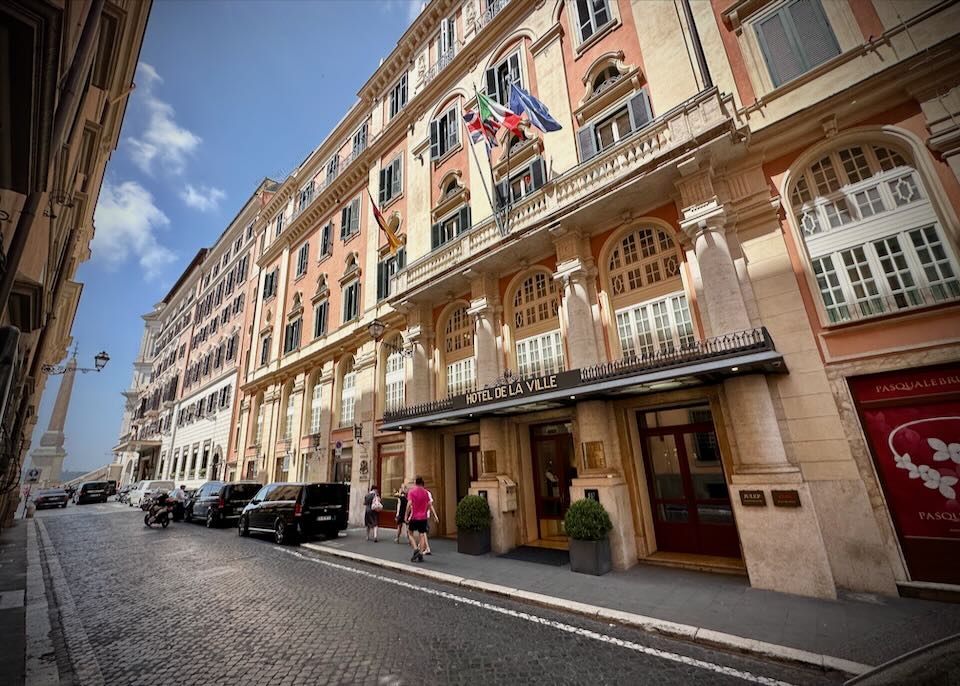
The 5-star Rocco Forte Hotel de la Ville is located just past the obelisk at the top of the Spanish Steps.
- Best Luxury Hotels in Rome
Hassler Roma • Hotel de la Ville • Hotel Artemide • Hotel Vilòn • St. Regis • Villa Spalletti Trivelli- Best Boutique Hotels in Rome
Inn at the Roman Forum • Campo de’ Fiori • Portrait Roma • J.K. Place • San Anselmo • Hotel Santa Maria- Best New Hotels in Rome
Hotel Vilòn • Six Senses • Bulgari • Maalot Roma • EDITION- Best Hotels for Families in Rome
Internazionale Domus • Parco dei Principi • Hotel Canada • Hotel Grifo • Ripetta 25- Best Midrange/Value Hotels in Rome
Hotel Des Artistes • iQ Hotel • The RomeHello • Hotel CanadaOur room at the Inn at the Roman Forum. Great location for the Colosseum and Ancient Rome.
Our suite at the Internazionale Domus Hotel. A fantastic place to stay for families. Great location near the metro and Spanish Steps.
Best Places in Rome for…
- Best Neighborhoods to Stay for First Timers: Historic Center and Trastevere
The Historic Center is hard to beat for a first-time visit to Rome. It’s one of the city’s most beautiful districts and is perfectly placed to explore just about everywhere. Amongst its historic lanes, you’ll discover all manner of delightful shops, cafes, bars, and restaurants. Trastevere is another district that makes a fabulous first impression with its medieval streets, vibrant piazzas, and buzzing atmosphere. While not the quietest part of town, Trastevere offers some great (and cheaper) accommodation options.

My favorite neighborhood in Rome is Trastevere – a lively walkable area with good restaurants and nightlife. Santa Maria is a great hotel close to the action.
- Best Neighborhoods for Nightlife: Trastevere, Historic Center and Pigneto
Trastevere is one of Rome’s most lively districts. Its colorful lanes are awash with bars and cafes, and every night it buzzes with activity as crowds of locals and tourists pile in to enjoy the party vibe. (The Hotel Santa Maria is one of the area’s most magical places to stay.) Bar San Calisto is a justly popular 1960s throwback, but we also like Big Star Bar Diner for cocktails and live music, dive bar Mr. Brown Pub, and no-frills craft beer specialist Ma Che Siete Venuti A Fà. Back over the river, the Historic Center sees plenty of after-hours action with everything from swish designer bars to relaxed neighborhood cafes and piazza-side hangouts, especially around Piazza Navona (try La Botticella) and Campo de’ Fiori (Il Baretto is a good choice). For a more alternative scene, head to studenty San Lorenzo or to Pigneto, a trendy hub of bars and clubs east of Termini station – Club 55, Giove Live Music, and Spirito are fun spots here.Having a drink in Trastevere.
- Most Romantic Neighborhood: Aventine Hill
With a lofty hilltop location, memorable views, and elegant Art Nouveau villas, the Aventine is a wonderful area for couples and honeymooners. It’s a little off the main tourist path and doesn’t offer much accommodation (the San Anselmo and Villa San Pio are especially romantic and charming), but that just adds to its air of exclusivity. While there aren’t many must-see sights here, the Giardino degli Aranci (Orange Garden) is a divine spot to catch the sunset, and the Villa del Priorato di Malta boasts a fabulous keyhole view of St Peter’s Basilica.- Best Neighborhood for Food & Restaurants: Testaccio
For an authentic culinary experience, head to Testaccio, the birthplace of Rome’s traditional nose-to-tail cuisine. The neighborhood is brimming with exceptional, time-honored trattorias to explore. Highly recommended establishments include Ristorante Pecorino, Osteria degli Amici, Taverna Volpetti, and Osteria San Giorgio, but you’ll find plenty of other delightful options as well. For lunch it’s hard to beat the Mercato di Testaccio, where stalls such as Casa Manco (pizza) and Mordi & Vai (panini sandwiches) knock out superb street food at low prices. For pizza and supplì (rice balls) head to Trapizzino. Rome is also famous for its Jewish cuisine, originally developed by cooks confined to the city’s Ghetto. For a taste, try one of the excellent restaurants along Via del Portico d’Ottavia, in the old Jewish Quarter of the Historic Center.
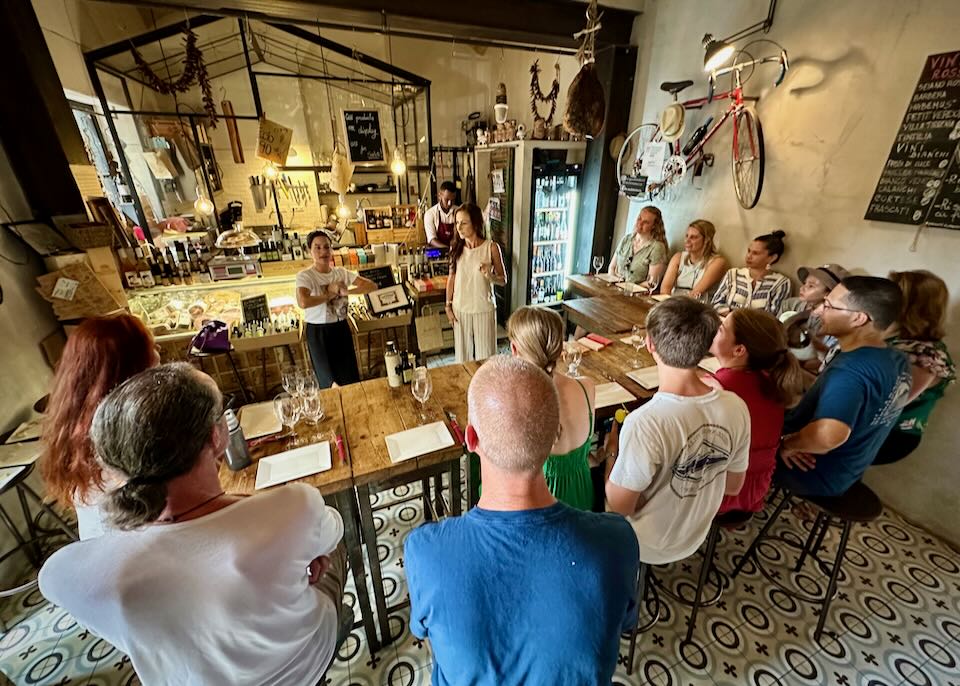
A guided food tour that we did in Testaccio.
- Best Neighborhoods for Local Vibe: Ostiense and Testaccio
South of the city center (but easy to reach by metro), the Testaccio and Ostiense neighborhoods offer a slice of authentic Rome. There are a handful of attractions (the Mattatoio and Centrale Montemartini art galleries, the tombs of Shelley and Keats in the Non-Catholic Cemetery), but this area is just as much about its shops, neighborhood markets, and popular eateries than its tourist sights. In particular, up-and-coming Ostiense is known for its street art and murals by Italian artist Blu (and others), the Basilica of St. Paul Outside the Walls (the supposed resting place of St Paul himself), vegan restaurants like Romeow Cat Bistrot, and Eataly Roma, the global Italian food emporium housed in the old Ostiense Station.- Best Neighborhoods for Sightseeing: Ancient Rome, Historic Center, and Vatican/Prati
There are three main sightseeing areas in Rome: Ancient Rome, the Historic Center, and the Vatican. Ancient Rome, centered on the Colosseum and the Roman Forum, is home to the city’s most celebrated ancient ruins. To the north, the Historic Center is scattered with artistic treasures and headline sights such as the Pantheon and Trevi Fountain. Across the river, Vatican City features St Peter’s Basilica and the Vatican Museums, home of the Sistine Chapel. All three areas have a good variety of hotels.We find that we get the most out of any historic site visit when we book a guided tour. And this was especially true of the Roman Forum.
- Best Neighborhoods for Shopping: Historic Center, Monti, Trastevere
Rome’s designer boutiques cluster in the streets close to the Spanish Steps and the Via dei Condotti. Mainstream and chain fashion stores can be found on Via del Corso a little to the west, as well as Via Cola di Rienzo (in Prati), while indie shops line Via del Governo Vecchio. Narrow Via dei Coronari and the nearby streets are known for antiques, as well as fashion. You’ll find smaller alternative stores in Monti (like Flamingo Vintage, Radiation Records, and Pifebo Vintage Shop), as well as in Trastevere. The Almost Corner Bookshop in Trastevere is one of Rome’s best English bookshops. If you’re around, don’t miss the Sunday flea market at the Porta Portese, with hundreds of stalls stretching down Via Portuense to Trastevere train station (come at 7am to peruse the best bargains).
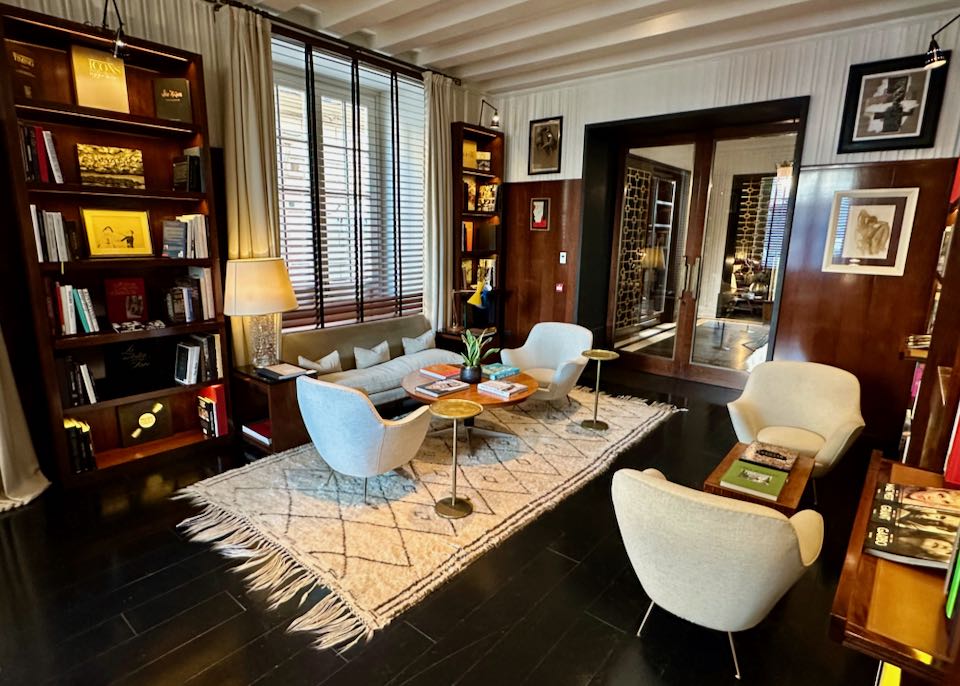
The J.K. Place hotel has a great central location (10-minute walk from the Trevi Fountain) and a luxurious charm.
- Safest Areas of Rome
Rome is a safe city, with no dangerous areas in the city center. For a quiet, well-connected neighborhood, consider Prati. Easily accessible by metro and conveniently located for the Vatican, Prati offers an abundance of affordable hotels and eateries. Another peaceful (at night) central area is the upscale district surrounding the Spanish Steps and Piazza del Popolo. Known as Rome’s designer shopping hub, this area becomes delightfully serene once the stores and boutiques close for the day.- Unsafe Areas of Rome
The area around Termini station is often made out to be a dangerous area at night, but with so many people around at all hours you are unlikely to experience any problems (as always, be on the lookout for pickpockets and phone snatchers). The neighborhoods reporting the highest crime rates in Rome tend to be on the outskirts of the city to the east and south – but few tourists visit those areas.The 8 Best Areas in Rome for Tourists
1. Historic Center (Centro Storico) and Jewish Quarter
For the heart of the action, Rome’s Historic Center is the place to be. It is a touristy part of town but locals also enjoy its excellent restaurants and trattorias, fashionable boutiques, and busy bars and cafes. Those staying in Centro Storico will have top sights such as the Pantheon, Museo di Roma (Palazzo Braschi), Galleria Doria Pamphilj, Spada Gallery, and the Piazza Navona’s grand Neptune Fountain at their doorstep, along with countless historic churches (like Borromini’s Sant’Ivo and the Gesù, mother church of the Jesuits) and cobbled lanes to explore. Campo de’ Fiori is one of the city’s liveliest squares, home to a produce market and the famous monument to Renaissance thinker Giordano Bruno, while the Palazzo Altemps displays the Museo Nazionale Romano’s best statuary.
Piazza Navona
The southern section of the historic district encompasses the old Jewish Quarter (or “Ghetto”), home to the impressively grand Tempio Maggiore, the great Synagogue and Jewish Museum, plus the Fondazione Museo della Shoah, which is a moving reminder of the Holocaust in Italy. Locals flock to the Roman-Jewish restaurants on Via del Portico D’Ottavia (featuring dishes like artichokes alla giudia and anchovy pie), while its ancient portico leads to the ruined Temples of Apollo Sosiano and Bellona, and the Teatro di Marcello, a smaller version of the Colosseum founded by Julius Caesar.
The boundary between the Historic Center and Ancient Rome is marked by traffic-snarled Piazza Venezia, dominated by the monumental Altare della Patria (or “Vittoriano”), commemorating Italian Unification.
Altare della Patria in Piazza Venezia.
The Historic Center is carpeted with hotels, so you’ll find plenty of choice in Rome’s most central and liveliest district. But be aware that there are some downsides here, too: it’s the busiest part of the city and is often overwhelmed by tourists, rates tend to be expensive (though we’ve listed some good bargains below), and its narrow streets are far from the nearest metro stations (the closest public transport options are trams and buses on the periphery).
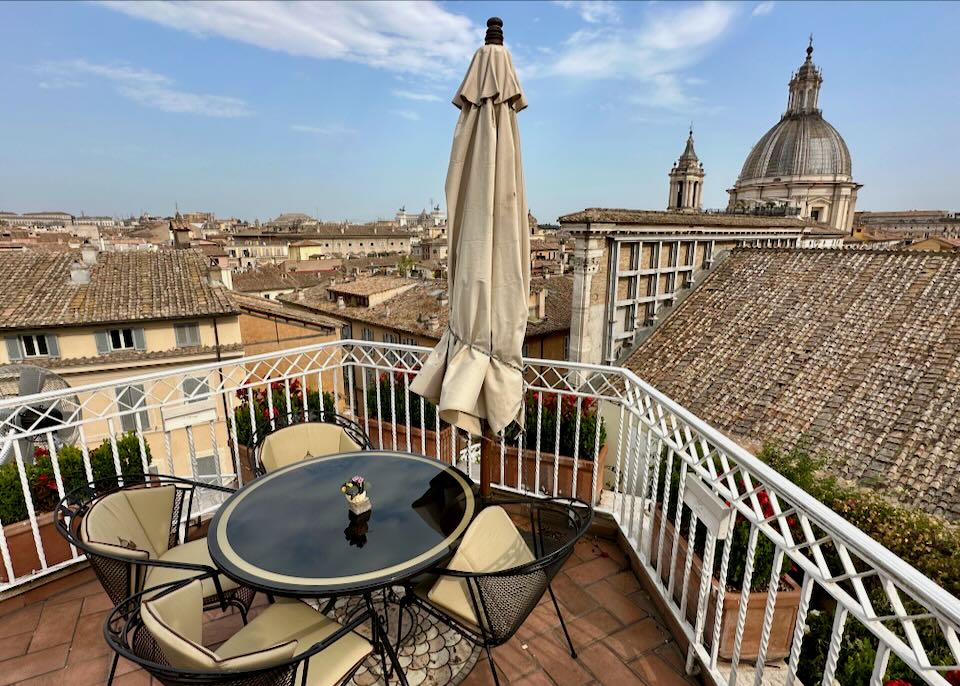
Views of Rome from the rooftop restaurant at Bio Raphael.
- Best Hotels in the Historic Center and Jewish Quarter
Bio Raphael • Hotel phone: +39 06 682831
Campo de’ Fiori • Hotel phone: +39 06 687 4886
Chapter Roma • Hotel phone: +39 06 8993 5351
Hotel Damaso • Hotel phone: +39 06 4550 3061
Hotel De’Ricci • Hotel phone: +39 06 687 4775
Singer Palace • Hotel phone: +39 06 697 6161
Six Senses • Hotel phone: +39 06 868 14000
9Hotel Cesari • Hotel phone: +39 06 674 9701- Best Cheap/Midrange Hotels
Albergo del Senato • Hotel phone: +39 06 678 4343
HT6 Hotel • Hotel phone: +39 06 6880 9597
Nikis Collection Navona • Hotel phone: +39 350 029 99132. Tridente and Trevi Fountain (Historic Center)
The northern half of the Historic Center is characterized by the area known as the “Tridente”, named after the three streets that run south from Piazza del Popolo in the form of a trident: Via di Ripetta (to Piazza Cardelli), Via del Corso (to Piazza Venezia), and Via del Babuino (to Piazza di Spagna). Upmarket, elegant, and touristy, this area encompasses Rome’s top shopping strip, Via de’ Condotti – running east from Piazza di Spagna, home to the Spanish Steps, the Keats-Shelley House, and Babington’s 19th-century tea room. 600 meters south from Piazza di Spagna lies one of the city’s most popular attractions, the Trevi Fountain of La Dolce Vita fame – plan to visit very early if you want to avoid the crowds.
Don Pasquale restaurant and bar, inside the newly-opened Maalot Roma hotel.
Nestled among the high-end designer boutiques and prestigious flagship stores, the historic district boasts charming cafes, such as the iconic Antico Caffè Greco, and several sophisticated bars frequented by affluent Romans and visiting celebrities. Notable attractions include the colossal Mausoleum of Augustus and the adjacent Museo dell’Ara Pacis, showcasing a Roman altar within its contemporary architecture masterfully designed by New York-based Richard Meier. Additionally, the Tempio di Adriano presents a rare, preserved façade of a Roman temple on site. For an immersive experience of Rome’s finest Renaissance art, visit the awe-inspiring church of Santa Maria del Popolo, which proudly displays masterpieces by Caravaggio and Raphael. While the Tridente district bustles with activity during the day, it transforms into a serene haven come nightfall.
There’s a huge choice of hotels here, mostly expensive, though there are still a few bargains to be had. And while it’s great to be in the heart of things, note that this area can be jam-packed with tourists during the day and that the metro and most buses bypass this area, meaning more walking (or taxis) for you.
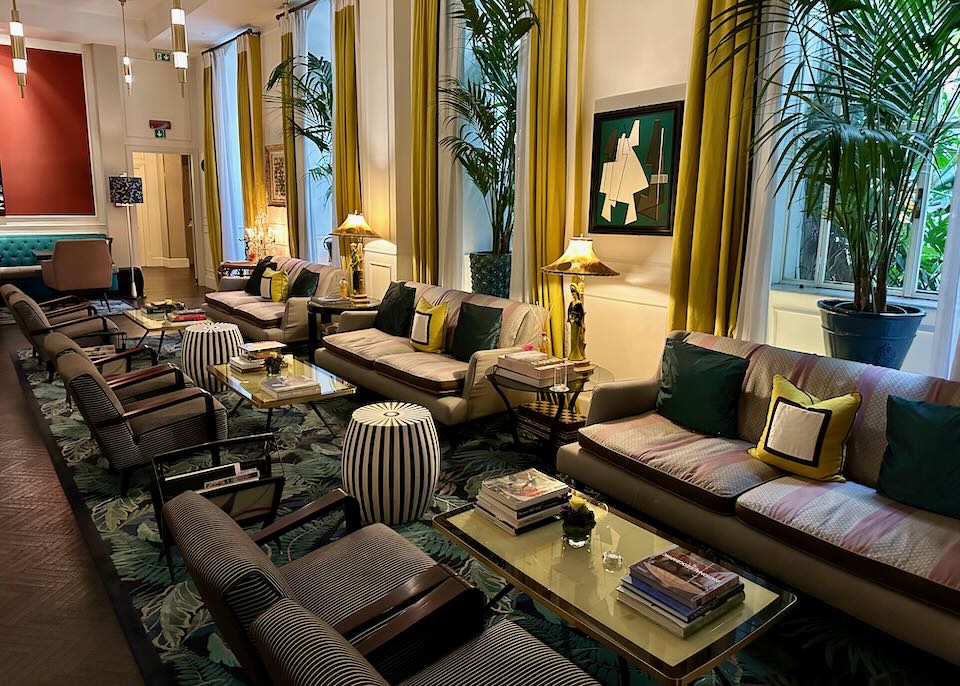
The swanky lobby lounge of the Hotel Vilòn.
- Best Hotels in Tridente and Trevi Fountain Area
Hassler Roma • Hotel phone: +39 06 699340
Bulgari • Hotel phone: +39 06 3608 0400
Hotel de Russie • Hotel phone: +39 06 328881
Hotel de la Ville • Hotel phone: +39 06 977931
Hotel Vilòn • Hotel phone: +39 06 878187
Internazionale Domus • Hotel phone: +39 06 6919 0237
J.K. Place • Hotel phone: +39 06 982634
Maalot Roma • Hotel phone: +39 06 878087
Portrait Roma • Hotel phone: +39 06 6938 0742
Villa Spalletti Trivelli • Hotel phone: +39 06 4890 7934- Best Cheap/Midrange Hotels
Albergo delle Regioni • Hotel phone: +39 06 6936 7981
Maison Evelina • Hotel phone: +39 366 890 5884
Poēsis Experience Hotel • Hotel phone: +39 06 9933 3369
Ripetta 25 • Hotel phone: +39 06 3265 05743. Ancient Rome (including Capitoline Hill and Monti)
Sightseeing is the main activity in Ancient Rome, the part of town centered on the Colosseum and ancient forums (Foro Romano is the most famous of these). There are several good accommodation options here, but fewer decent restaurants than in other areas. The main attractions begin on the Capitoline Hill, behind the giant Altare della Patria; the statue-lined Cordonata Capitolina staircase leads up to the Michelangelo-designed Campidoglio square, home to the Santa Maria in Aracoeli church (with frescoes by Pinturicchio) and Capitoline Museums, with their world-class collections of ancient sculpture and art.
Capitoline Museums
Ancient Rome stretches out to the southeast from here, the most densely packed section of Roman ruins in the city. The huge site of the Roman Forum (including Palatine Hill), the Imperial Forums, Trajan’s Markets, Domus Aurea (the remains of Emperor Nero’s palace), Arch of Constantine, and the Colosseum itself are all unmissable. Where possible, book tickets and time slots in advance online, as the crowds here can be overwhelming.
A short hop away, Monti is a favorite haunt of Rome’s boho set and exudes a laid-back village vibe from its hip boutiques, popular bars, and excellent restaurants. The center of action is Piazza Madonna dei Monti, but there’s also plenty going on around Via Leonina, Via Cavour, and Via Urbana. Make time for the church of San Pietro in Vincoli, home to Michelangelo’s statue of Moses, Leah, and Rachel (and the supposed chains of St Peter).
Church of San Pietro in Vincoli
There are a few hotels near the forums, but these tend to be expensive and a little out of the way. In contrast, there are plenty of good value hotels in Monti (which is much livelier) and east of the Colosseum (in Celio), but be picky, some of these are not great (though never too dire).
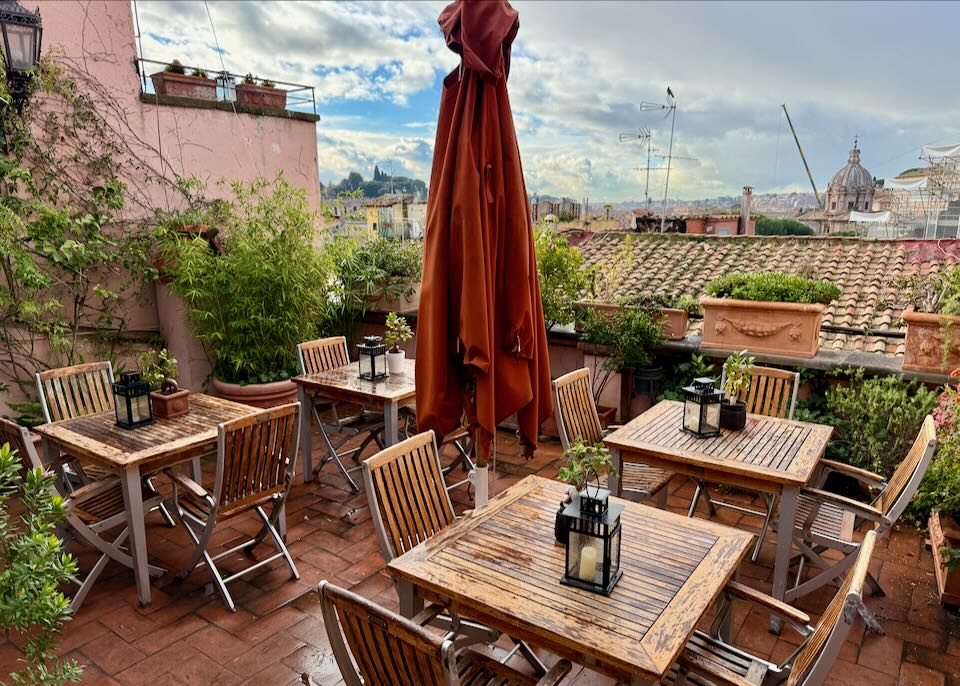
The view of Ancient Rome from the Inn at the Roman Forum – where we stayed on our last visit. (Fantastic breakfasts!)
- Best Hotels in the Ancient Rome and Monti
47 Boutique Hotel • Hotel phone: +39 06 678 7816
H10 Palazzo Galla • Hotel phone: +39 06 429810
Hotel Lancelot • Hotel phone: +39 06 7045 0615
Inn at the Roman Forum • Hotel phone: +39 06 6919 0970
Nerva Boutique Hotel • Hotel phone: +39 06 678 1835
NH Collection Fori Imperiali • Hotel phone: +39 06 6976 89911
Palazzo Manfredi • Hotel phone +39 06 7759 1380- Best Cheap/Midrange Hotels
DoubleTree Rome Monti • Hotel phone: +39 06 4577 4500
Hotel Grifo • Hotel phone: +39 06 487 1395
Zefiro Home B&B • Hotel phone: +39 335 694 82124. Trastevere
Across the river from the Historic Center lies Trastevere, a charming maze of medieval streets and lively piazzas. This area is home to several noteworthy sites, including art-adorned churches such as the Basilica di Santa Maria in Trastevere, the Basilica of Santa Cecilia (with frescoes by Cavallini), and San Francesco a Ripa Grande, which houses Bernini sculptures and De Chirico’s tomb. Additional attractions include the 16th-century Palazzo Corsini, which houses the National Gallery of Ancient Art and Rome’s Botanical Garden; the Villa Farnesina, adorned with Raphael’s stunning frescoes; and the Museo di Roma in Trastevere, which documents local history. Every Sunday, the Porta Portese flea market takes place from 7 am to 2 pm.
During the day, Trastevere is perfect for leisurely exploration, but it truly comes alive at night, bustling with tourists and locals alike. Trastevere offers a diverse dining scene, from Michelin-starred restaurants to authentic neighborhood pizzerias and cozy cafes. To reach Trastevere, stroll across the picturesque Isola Tiberina in the middle of the Tiber River, crossing the Ponte Fabricio – an ancient Roman bridge built in 62 BC.
Trastevere is rich in character but not as convenient for sightseeing as the Historic Center; it’s not on the metro lines, but is linked by buses and trams. Because of this, it’s generally cheaper to stay in Trastevere than in the city center, with more B&Bs, apartment rentals, and family-run guesthouses to choose from.
- Best Hotels in Trastevere
Donna Camilla Savelli • Hotel phone: +39 06 588861
Giuditta In Trastevere • Hotel phone: +39 348 018 1008
Le Clarisse • Hotel phone: +39 06 5833 4437
Residenza San Calisto • Hotel phone: +39 393 973 5447
Ripense In Trastevere • Hotel phone: +39 06 581 2870
Hotel Santa Maria • Hotel phone: +39 06 589 4626- Best Cheap/Midrange Hotels
B&B Trastevere’s Friends • Hotel phone: +39 06 9357 7587
Domus Corsini • Hotel phone: +39 388 198 5023
Nikis Collection Trastevere • Hotel phone: +39 350 551 3688
Residenza delle Arti • Hotel phone: +39 389 496 46085. Villa Borghese and Barberini
Northeast of Rome’s Historic Center lies Villa Borghese, the city’s Central Park. This green oasis provides a perfect respite and houses several exceptional art museums, including the renowned Borghese Gallery (advance booking required), Villa Medici, and Museo Carlo Bilotti. On the park’s north side, you’ll find the National Gallery of Modern and Contemporary Art and the National Etruscan Museum of Villa Giulia, which showcases precious artifacts from the ancient Etruscan civilization. The park’s Terrazza Viale del Belvedere offers great views of the Historic Center, the Vatican, and Piazza del Popolo.
Leading up to the park from Piazza Barberini, the wide, tree-lined Via Vittorio Veneto is lined with luxurious hotels and elegant sidewalk restaurants. Along this avenue, you can also visit the Museo e Cripta dei Frati Cappuccini, a medieval monastery and crypt, the National Gallery of Ancient Art in Barberini Palace, and the Galleria d’Arte Moderna.
Quiet at night, this area is well positioned for exploring the city while also offering some relief from the crowds. You’ll find very expensive chain hotels (the W, Westin, etc) south of the park.
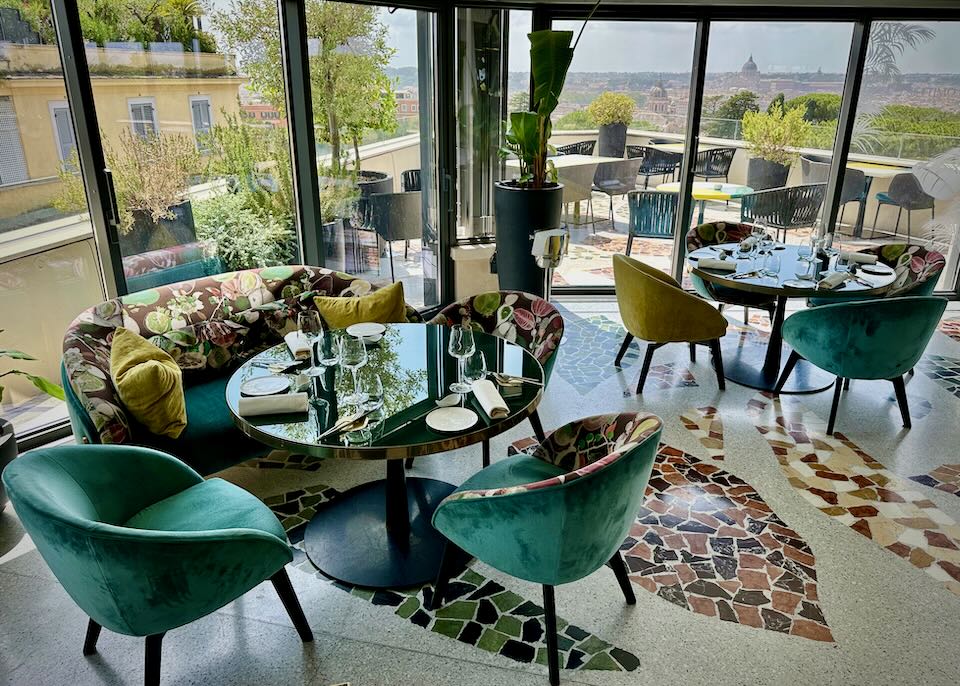
Incredible views over Rome’s seven hills and St. Peter’s Basilica from the rooftop restaurant of the Sofitel Villa Borghese.
- Best Hotels near Villa Borghese and Barberini
Baglioni Hotel Regina • Hotel phone: +39 06 421111
Eden • Hotel phone: +39 06 478121
The Hoxton • Hotel phone: +39 06 9450 2700
Parco dei Principi • Hotel phone: +39 06 854421
The Regency • Hotel phone: +39 06 9468 2000
Sofitel Villa Borghese • Hotel phone: +39 06 478021
Splendide Royal • Hotel phone: +39 06 421689- Best Cheap/Midrange Hotels
Domus RomAntica • Hotel phone: +39 331 245 6137
Palm Gallery • Hotel phone: +39 06 6478 1859
Relais Donna Lucrezia • Hotel phone: +39 334 731 36576. Termini Station and Around
Most of Rome’s budget accommodation is found in the area around Stazione Termini. This is not the most attractive part of town, but nor is it as bad as it’s sometimes made out to be, though its facilities, restaurants, and cafés are squarely aimed at tourists. There are several exceptional museums nearby, such as the Baths of Diocletian and the Palazzo Massimo alle Terme, as well as remarkable churches like Santa Maria degli Angeli e dei Martiri and the grand Basilica Papale di Santa Maria Maggiore.
The Fountain of the Naiads at the Piazza della Repubblica near Termini Station.
To the west, discover a collection of majestic baroque palaces, including Palazzo del Quirinale, Italy’s presidential palace (accessible by guided tour only). Nightlife in the area is concentrated in two areas east of Termini: youthful San Lorenzo and Pigneto, a shabby-chic quarter full of bars and trendy restaurants.
Despite being a long walk or ride from the Historic Center, this is a massive tourist hub – and can be very convenient if traveling by subway or train. Though much of the budget accommodation here is of poor quality, we’ve listed the exceptions below. There are also some big five-stars in the area, notably the St Regis.
- Best Hotels near Termini Station
Anantara Palazzo Naiadi • Hotel phone: +39 06 489381
Hotel Artemide • Hotel phone: +39 06 489911
Palazzo Montemartini • Hotel phone: +39 06 45661
St. Regis • Hotel phone: +39 06 47091- Best Cheap/Midrange Hotels
Diocleziano • Hotel phone: +39 06 4890 0767
Hotel Canada • Hotel phone: +39 06 445 7770
Hotel Cellini • Hotel phone: +39 06 4782 5204
Hotel Des Artistes • Hotel phone: +39 06 445 4365
iQ Hotel • Hotel phone: +39 06 488 0465
Vanella Rome Domus • Hotel phone: +39 320 461 6436
The RomeHello • Hotel phone: +39 06 9686 00707. Testaccio, Aventine Hill (Aventino), and Ostiense
Located south of the city center and off the tourist radar, Testaccio is a former working-class neighborhood on the rise. It features intriguing sites such as the church of Santa Maria Liberatrice and the Mattatoio art museum, housed in a repurposed slaughterhouse. Nearby, you’ll find the Non-Catholic Cemetery, the final resting place of Romantic poets Percy Bysshe Shelley and John Keats, as well as the striking Pyramid of Caius Cestius. Testaccio is best known as a culinary hotspot, boasting authentic trattorias, traditional Roman cuisine, and food stalls within the indoor Mercato di Testaccio. The area is also home to popular clubs and discos that attract a youthful weekend crowd.
Testaccio Market
While accommodations are limited in Testaccio, the neighboring Aventine Hill offers several romantic retreats. Here, you can stroll along Via Santa Sabina to experience the famous “keyhole” view of St. Peter’s through the gate of the Priory of the Knights of Malta, or visit the ancient Basilica di Santa Sabina all’Aventino, the Municipal Rose Garden, or the Orange Garden, boasting stunning views of the city. To the southeast, explore the expansive Roman Baths of Caracalla, set amid picturesque parkland.
Further south, the unassuming Ostiense neighborhood is home to Centrale Montemartini, a former power plant converted into a classical art showcase for the Capitoline Museums.
Though metro connections are good down here, accommodation choices are few, making for a far less touristy experience. The best hotels tend to be scattered around the Aventine Hill, while Testaccio is the domain of small guesthouses and apartment rentals.
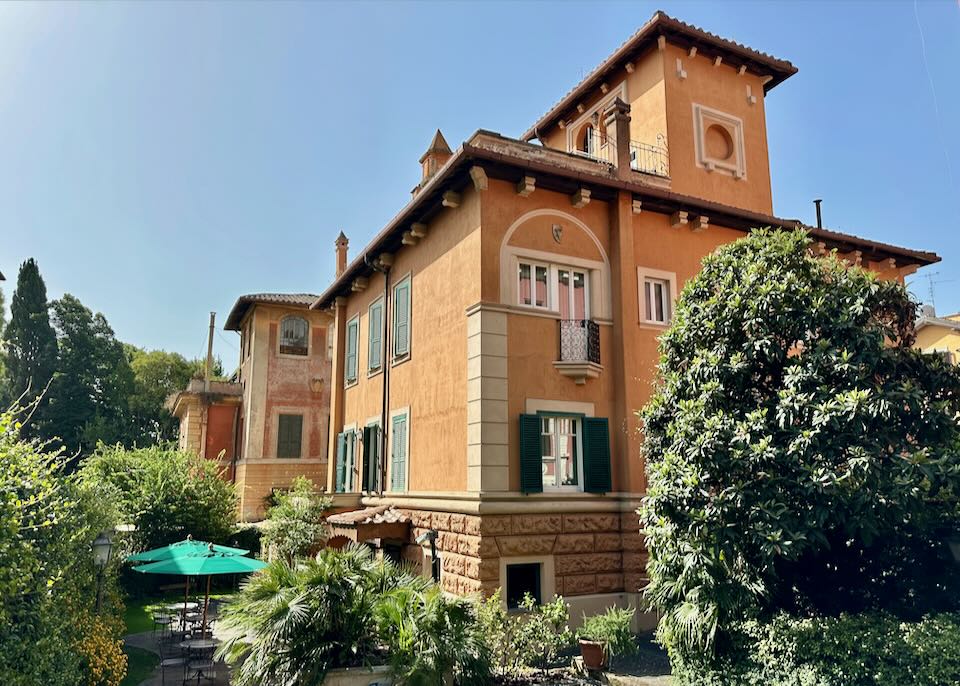
Villa San Pio is ideal for couples and honeymooners.
- Best Hotels in Aventine Hill, Testaccio, and Ostiense
Villa San Pio • Hotel phone: +39 06 570057
San Anselmo • Hotel phone: +39 06 570057
Seven Suites • Hotel phone: +39 06 574 81068. Vatican and Prati
On the left bank of the Tiber, Vatican City is home to some of Rome’s greatest sights. Throughout the day, crowds flock to St Peter’s Basilica, Bernini’s Piazza San Pietro, and the vast Vatican Museums; home to the Raphael Rooms, Sistine Chapel, and a mesmerizing cache of art treasures. It’s essential to reserve ahead for the museums and to arrive as early as possible at St Peter’s (which is free but has long lines for security checks).
St. Peter’s Basilica
Though small in size, the Vatican captivates visitors with its rich history and cultural significance. As there are no accommodations within its walls, most travelers opt to stay in the adjacent Prati district. Characterized by its modern, grid-planned layout and elegant Art Nouveau architecture, Prati emerged as an upscale residential area in the early 20th century. This neighborhood offers excellent shopping opportunities, particularly along Via Cola di Rienzo, as well as a plethora of dining options that include restaurants, trattorias, and takeout establishments. While Prati bustles with activity during the day, it settles into a more tranquil atmosphere at night. However, lively pockets remain, including Rome’s oldest jazz club, Alexanderplatz. Other noteworthy attractions include the family-friendly Leonardo Da Vinci Experience and the imposing Castel Sant’Angelo, a grand, circular fortress built atop Emperor Hadrian’s mausoleum by medieval popes, which now houses a fascinating museum.
Castel Sant’Angelo
There’s a huge stock of hotels in Prati to the north and east of the Vatican; most of it is affordable and pretty good value, comprising numerous B&Bs and small hotels. You’ll find even cheaper options to the south and to the west (Aurelio) – stay here if looking to save money.

Palazzo Cardinal Cesi is a beautiful historic hotel just a 2-minute walk to St. Peter’s Square.
- Best Hotels near the Vatican and Prati
Dei Mellini • Hotel phone: +39 06 324771
Orazio Palace • Hotel phone: +39 06 8401 0010
Palazzo Cardinal Cesi • Hotel phone: +39 06 684 0390
Villa Agrippina Gran Meliá • Hotel phone: +39 06 925901
Villa Laetitia • Hotel phone: +39 06 322 6776- Best Cheap/Midrange Hotels
B&B Annette • Hotel phone: +39 06 9727 5930
B&B Roma Borgo91 • Hotel phone: +39 06 9259 2658
Domus Alberico • Hotel phone: +39 320 557 6354
Domus Terenzio • Hotel phone: +39 345 087 0337
Folia Guesthouse • Hotel phone: +39 347 000 8387
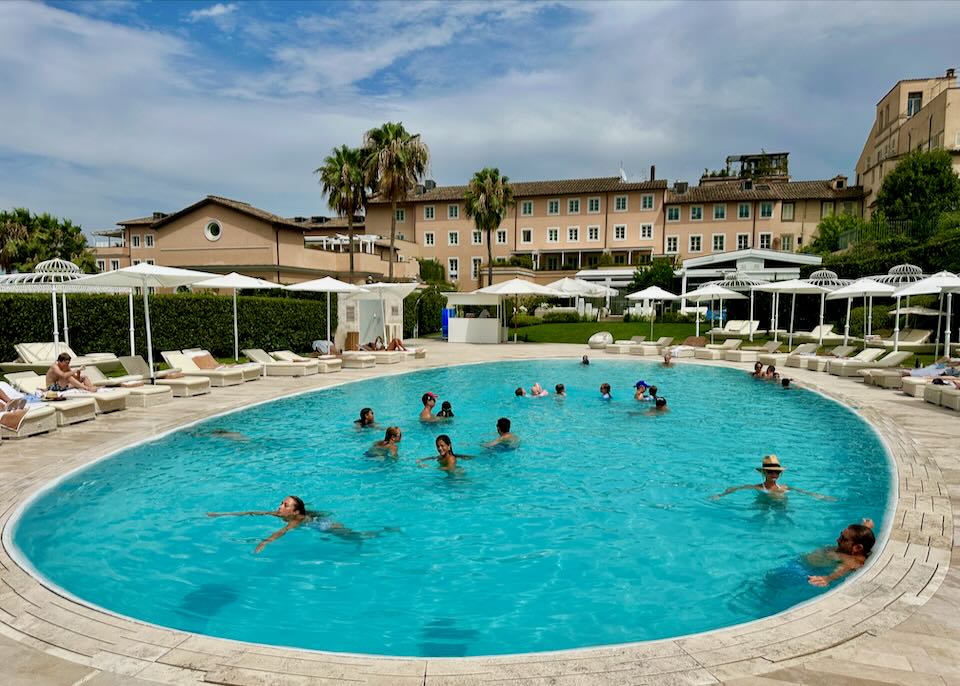
Villa Agrippina Gran Meliá has a relaxed vibe while being within an easy walk to the Vatican.
Rome Travel Tips
- Rome’s Fiumicino International Airport (FCO) is located about 22 miles (35km) southwest of the city center. Frequent Leonardo Express trains (every 15 minutes) shuttle between FCO and Termini Station in around 30 minutes; taxis charge a fixed rate of €50 for the trip into central Rome. Ciampino International Airport (CIA) is much smaller, located 7.5 miles (12km) southeast of central Rome, serving low-cost flights from Ryanair and Wizz Air. Travelers from Ciampino must take a taxi or bus/train combination to get into the city center.
- Having a car in Rome is a hassle and unnecessary expense. Rome’s public transportation system includes the Metro (subway), buses, and trams, providing visitors with ample ways to get around the city. Walking through Rome’s picturesque streets is often the best way to explore the city. Major attractions such as the Colosseum, the Roman Forum, Trevi Fountain, and Spanish Steps are within walking distance of each other. Rome’s historic center is compact and pedestrian-friendly, making it perfect for leisurely strolls (though the cobblestone streets are not stroller friendly). For slightly farther distances, consider renting a bicycle or using electric scooters, both readily available throughout the city. Taxis and rideshares are also options, but be prepared for slower travel times during peak traffic.
- With few exceptions, almost everyone you are likely to deal with in cosmopolitan Rome will be able to speak English (or at least understand some), but it’s a good idea to learn some basic words and numbers in Italian before you go. Outside of the city, things change dramatically – few people in rural Lazio speak English, especially in the older generation.
- A confusing array of tourist discount cards is offered for Rome – as always, these are a good value only if you intend to do a lot of sightseeing in a short amount of time. (Given how busy Rome is, though, the ability to gain fast track entry is definitely a bonus.) If you expect to spend a full 8 hours a day sightseeing, the 72-hour Omnia Card (€129) is the best option – it’s the most expensive card, but covers the most sights, public transport, and a hop-on hop-off bus (but not transport to Fiumicino airport). The Roma Pass is much cheaper and offers entry to two museums over 48 hours (€32) or 72 hours (€52); it includes free public transport (again, not to Fiumicino airport) and reduced admission to many other sights. The Vatican Museums are not included. If your primary focus is St. Peter’s Basilica, the Vatican Museums, and the Sistine Chapel, look into the Vatican City Pass.
- Bike rental is available in Rome through bike share schemes like Lime, Dott and Tier – e-scooters are also popular. With its hills, congested streets, and limited bike lanes, Rome isn’t a great city for biking, but there are some wonderful trails to seek out, especially the Lungotevere path along the Tiber.
- Roads in the city center are narrow, often one-way, and usually congested. Driving into Rome by car isn’t recommended unless you’re used to Italian roads and rules, and know where you are going to park (which can be expensive).
- Free wi-fi is available at both Rome airports, and at cafés and museums around the city. You can register for free access at thousands of free wi-fi hot spots throughout Rome and Italy.
More Rome Neighborhoods
We’ve covered our favorite neighborhoods to visit and stay in more detail above, but with more time the following districts are also worth checking out:
- Flaminio: North of the Historic Center and accessible by tram or bus, Flaminio is home to the futuristic Auditorium Parco della Musica, a concert hall designed by Renzo Piano, and the equally mind-bending MAXXI, the National Museum of Contemporary Art by Zaha Hadid. Just across the river you can watch some of the best European football at Stadio Olimpico, home of Italian Serie A teams AS Roma and Lazio. Great hotels here include Maison Flaminio, Guest House Vignola, and B&B Casa Cimabue.
- Appio Latino (San Giovanni): Situated opposite the Scala Santa (Holy Stairs) and Sancta Sanctorum (the Pope’s chapel), the imposing Basilica di San Giovanni in Laterano, also known as Rome’s cathedral, commands the northern section of this district. The area also encompasses the expansive Parco dell’Appia Antica, situated along the historic Appian Way. This vast green space is ideal for hiking and biking while also housing the city’s renowned catacombs, subterranean burial grounds that served as the final resting place for Rome’s early Christian communities – most notably at the churches of San Sebastiano and San Callisto. Other highlights include the Mausoleum of Cecilia Metella, the Villa of the Quintili, and the medieval Church of San Nicola (Castrum Caetani). You’ll find plenty of cheap guesthouses in the northern section, including Domus Appia 154 and King Plaza B&B, both convenient for the metro (Re di Roma station).
- EUR (Esposizione Universale Roma): Constructed under the reign of dictator Benito Mussolini in the 1930s and largely completed for the 1960 Olympics, this southern business district features an array of parks, lakes, and monumental Fascist-era architecture. But it is the assortment of museums that captivates visitors, including the National Museum of the Middle Ages, National Museum of Prehistory and Ethnography, National Museum of Arts and Popular Traditions, and the city’s Planetarium. EUR is an easy daytrip via metro from the city center and not worth staying overnight – the hotels down here are nothing special.
- Tivoli: For those with extra time, a highly recommended day trip is to Tivoli, situated in the Simbruini Hills approximately 18 miles northeast of Rome and accessible by a 50-minute local train ride. Tivoli’s highlights include the ancient Roman Villa Adriana (Emperor Hadrian’s grand palace ruins) and the Renaissance-era Villa d’Este, both of which are UNESCO World Heritage Sites. Additionally, Tivoli boasts an impressive array of monuments, Roman ruins, palaces, and churches to explore. Those opting to spend the night will find Antica Villa di Bruto and B&B La Panoramica to be excellent, romantic options.
- There’s not much point in staying near Rome–Fiumicino International Airport unless you have a very early flight. If you do need to stay here, the most convenient option is the in-terminal HelloSky, but the upmarket QC Termeroma just outside the airport is much better quality and the Sleep’n go Hotel is much cheaper.
Summary: My Favorite Hotels in Rome
• 5-Star: Hassler
• 4-Star: Artemide • Singer Palace
• 3-Star: Palm Gallery • HT6 Hotel
• For families: Internazionale Domus
• For couples: Inn at Roman Forum
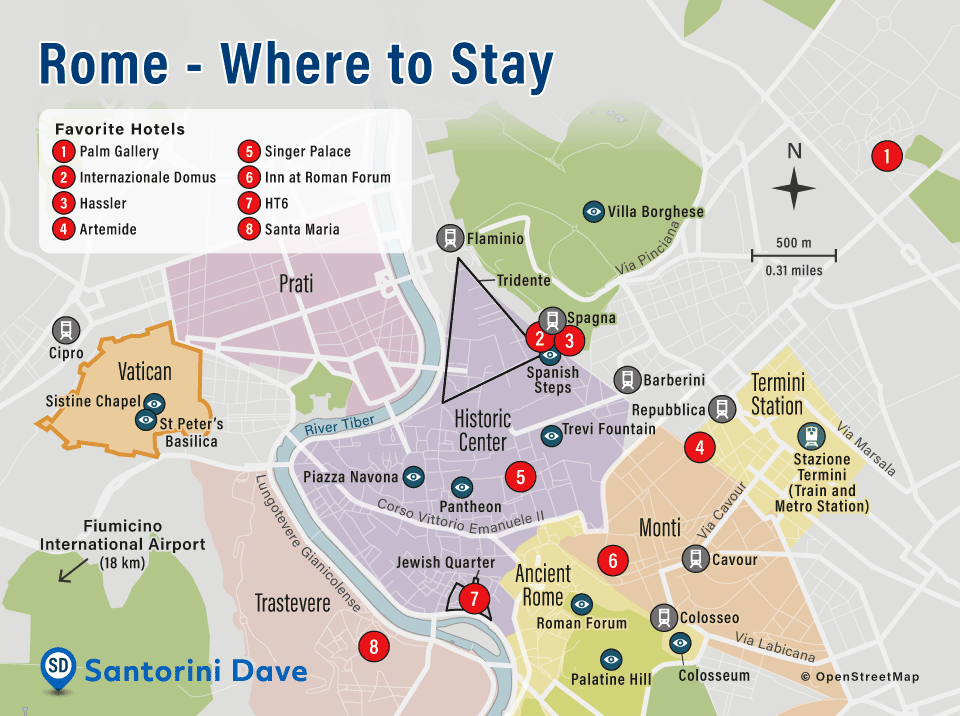
1. Palm Gallery • 2. Internazionale Domus • 3. Hassler • 4. Artemide • 5. Singer Palace • 6. Inn at Roman Forum • 7. HT6 • 8. Santa Maria
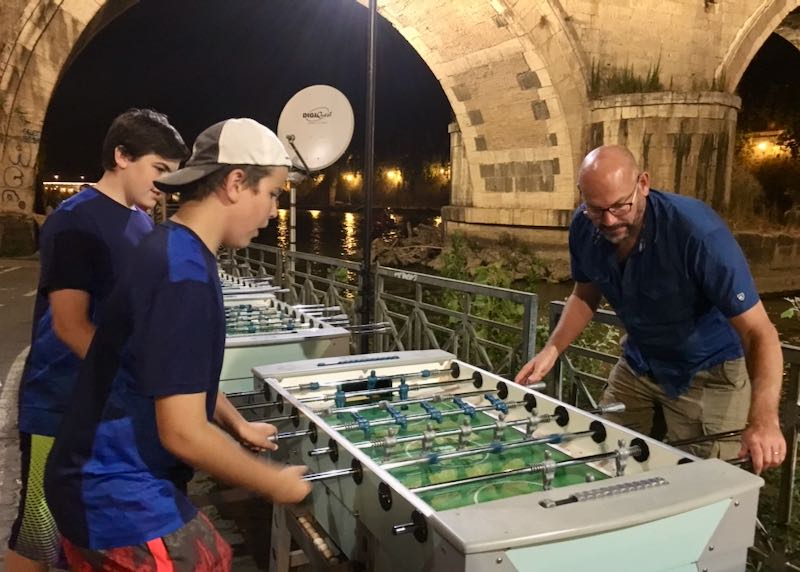
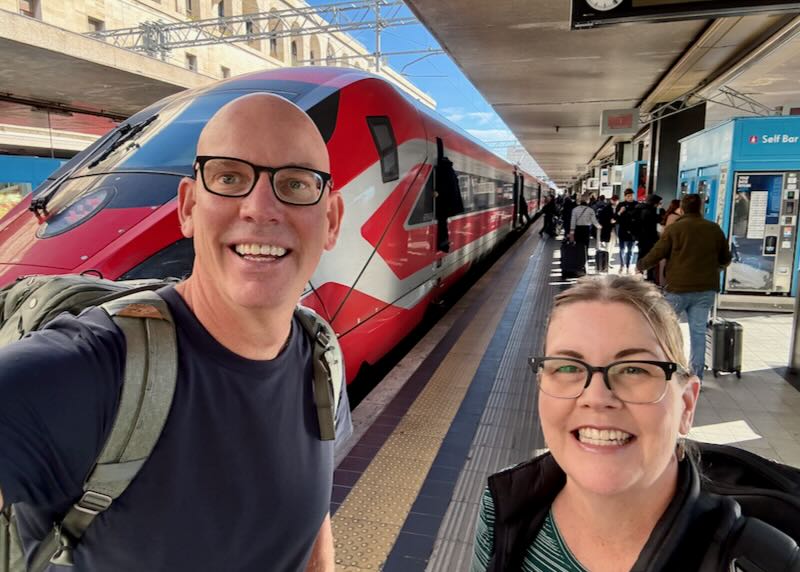
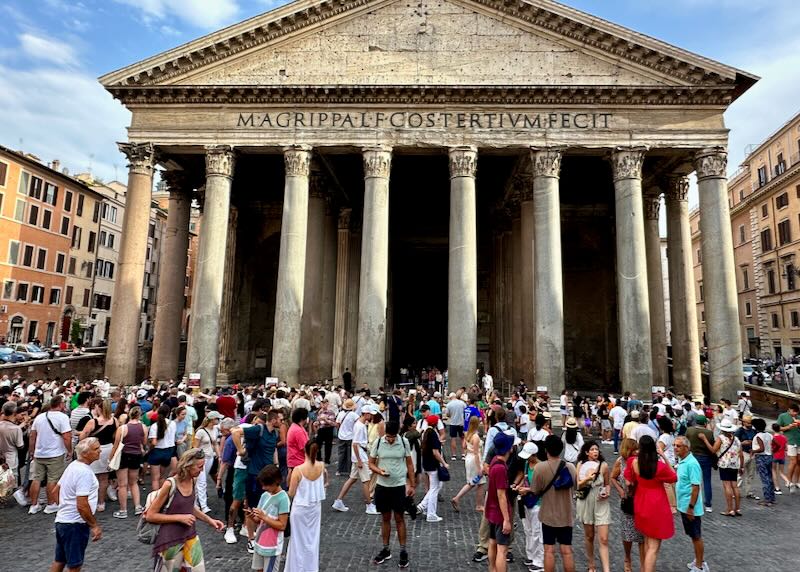
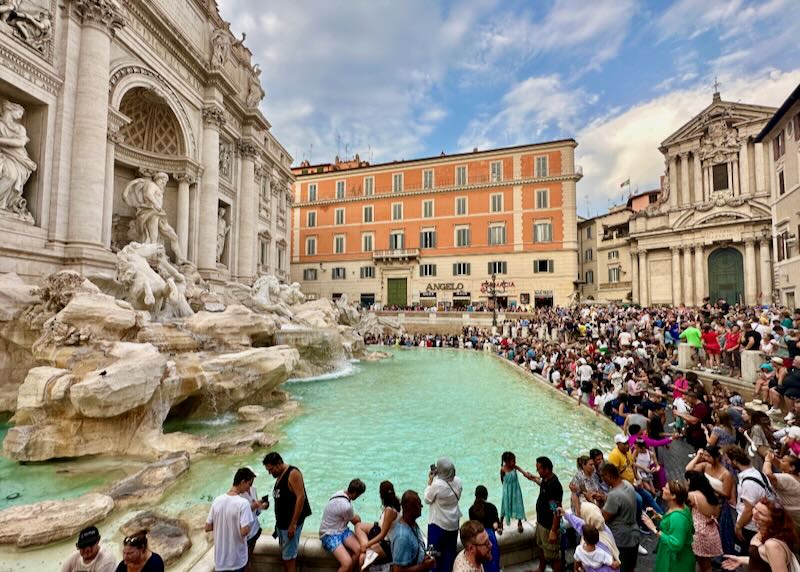
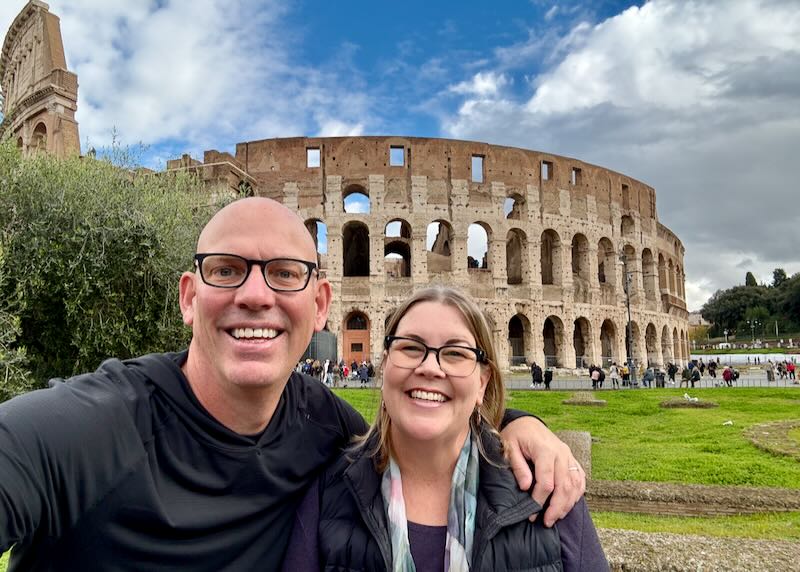
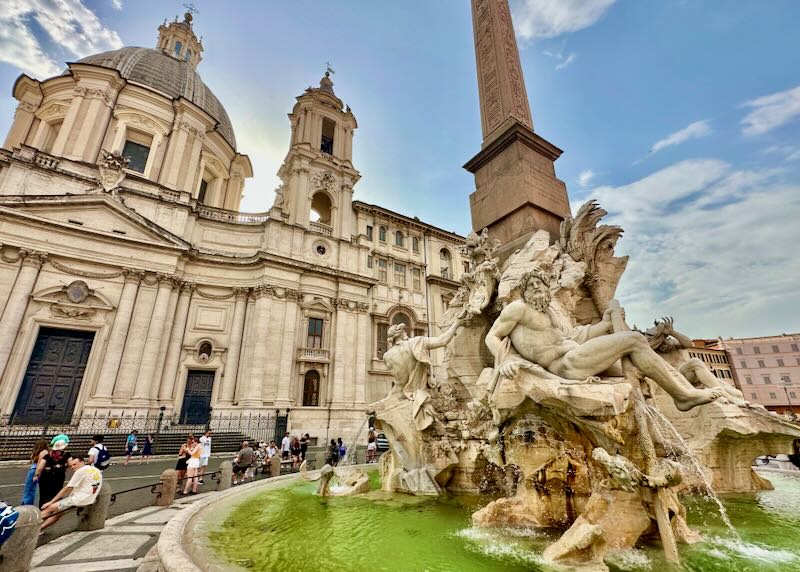
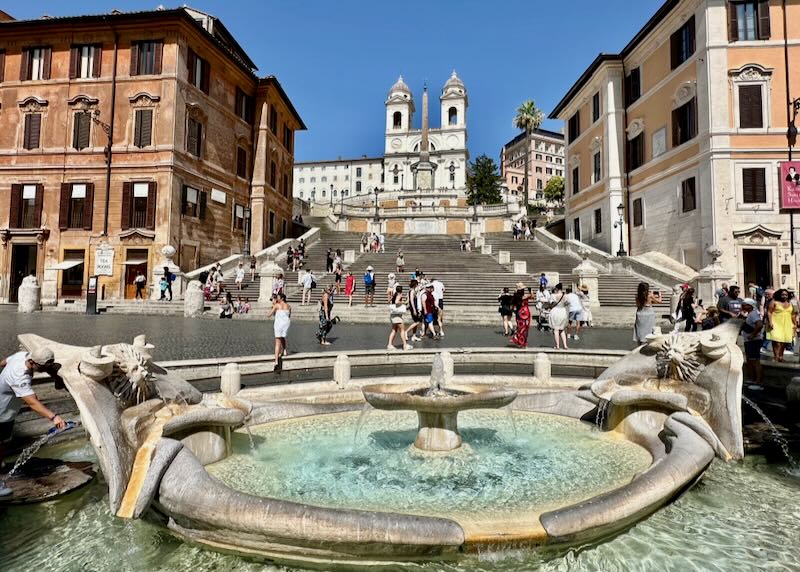
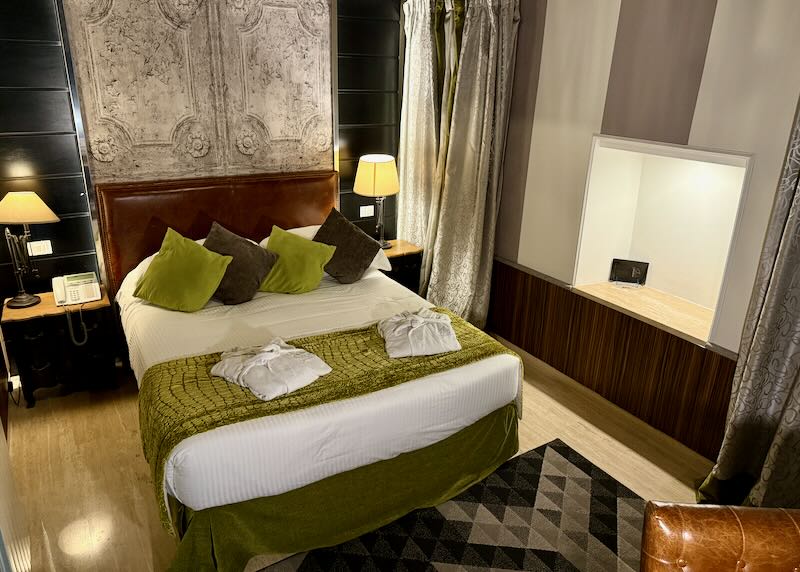
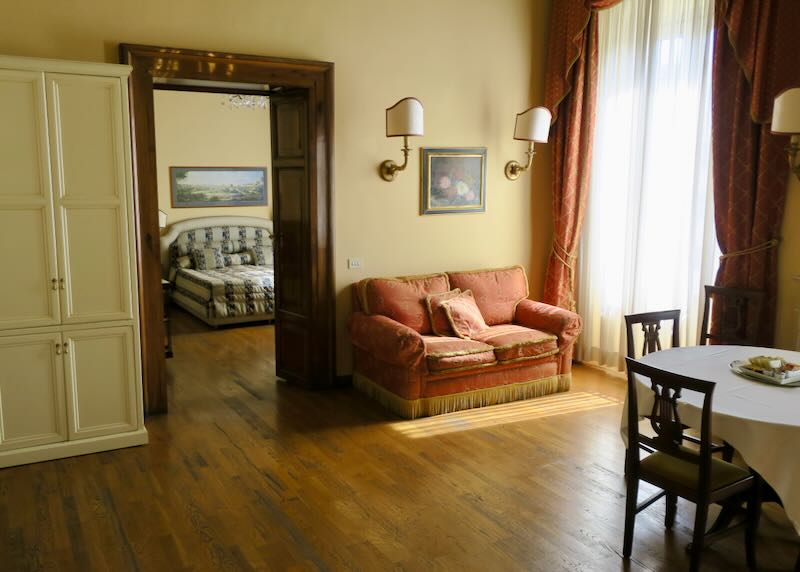
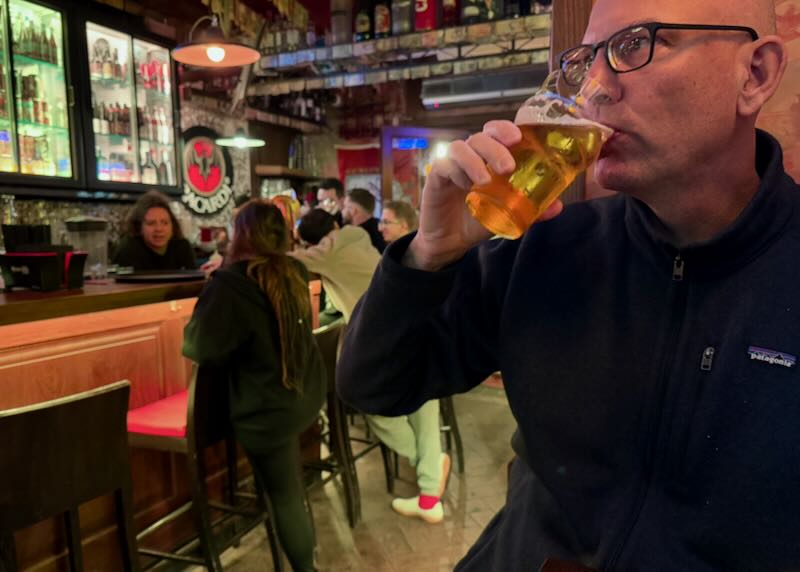
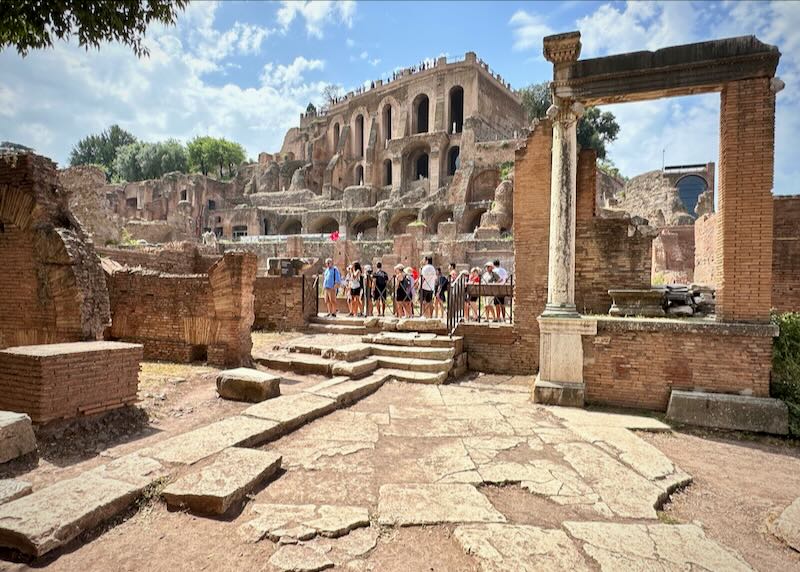
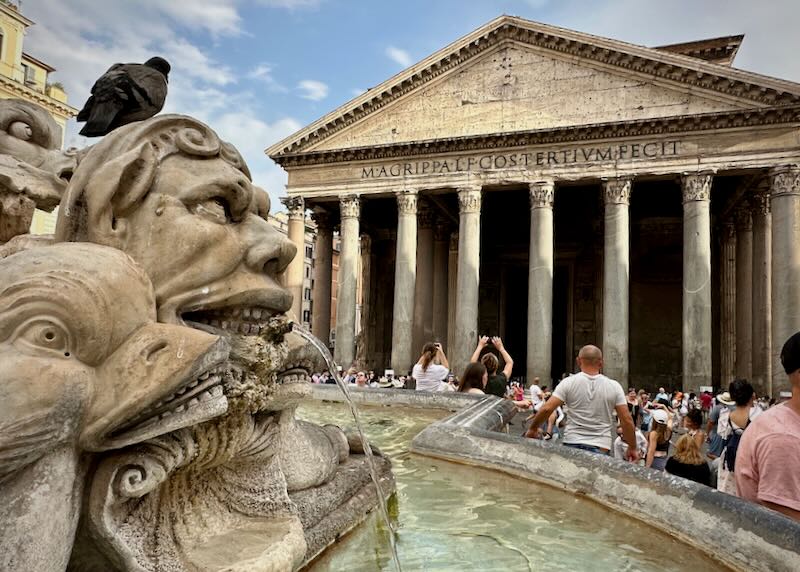

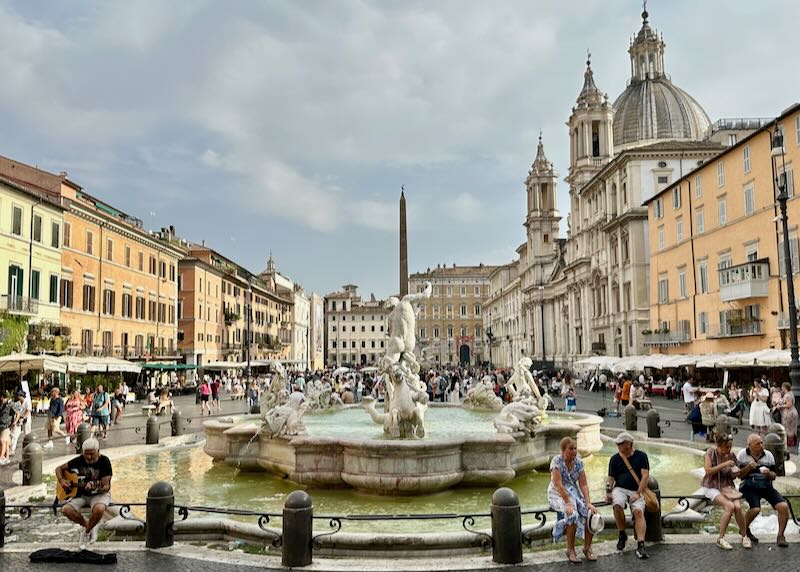
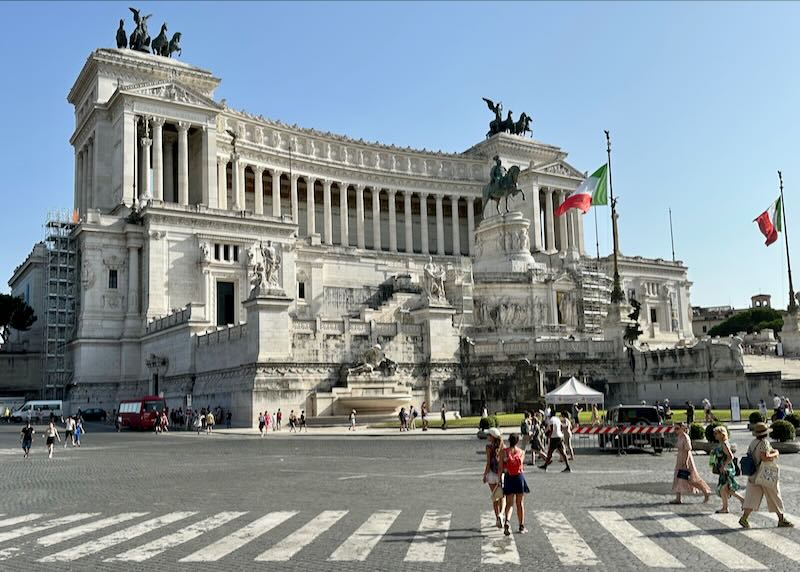
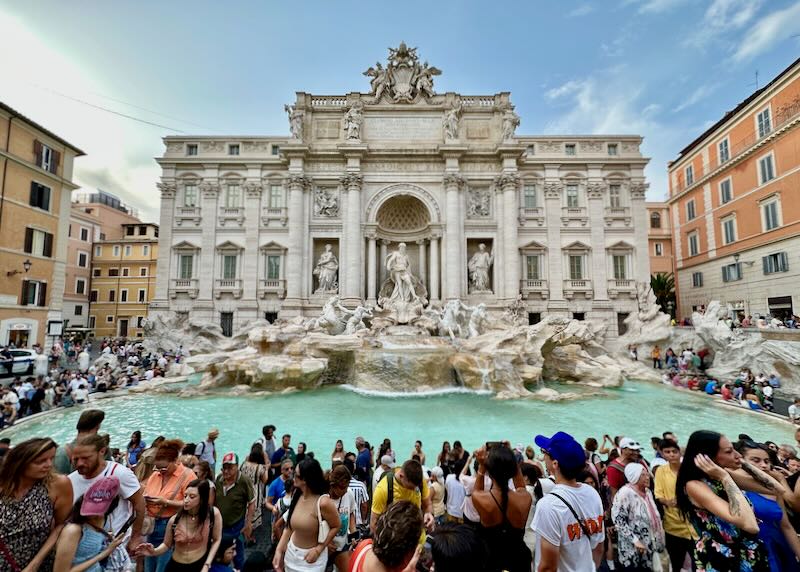

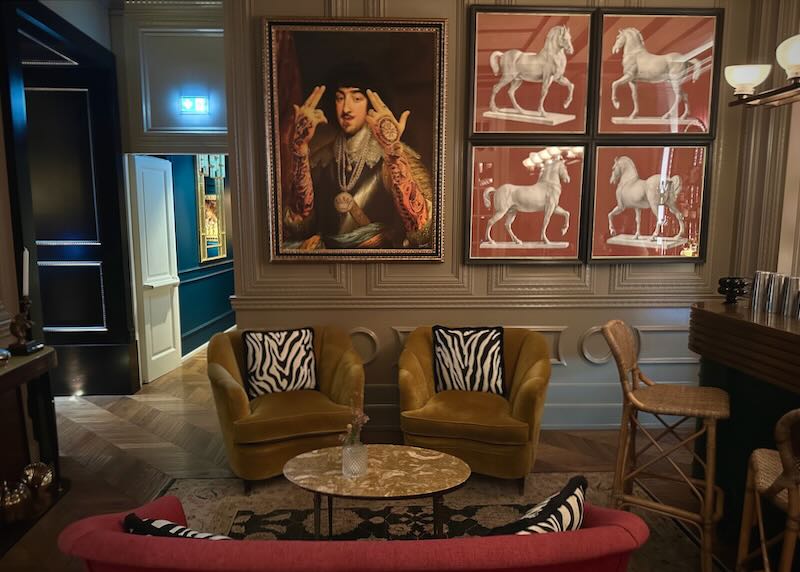
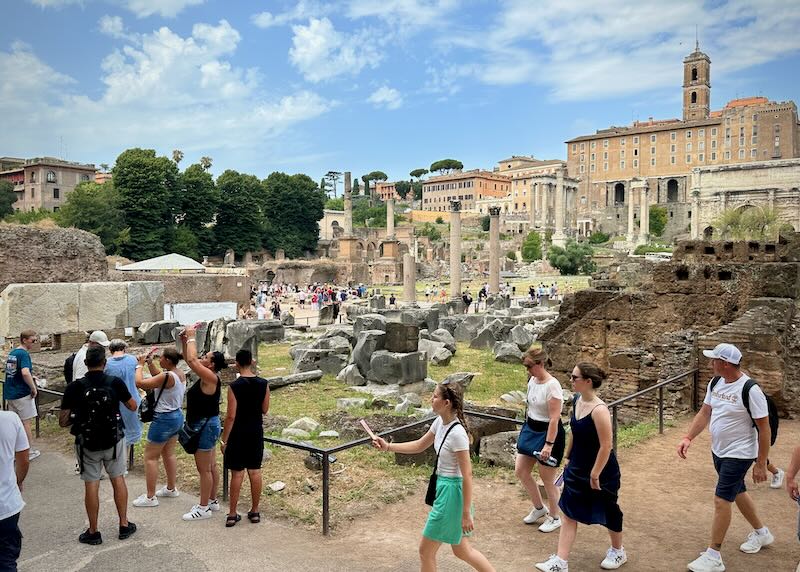

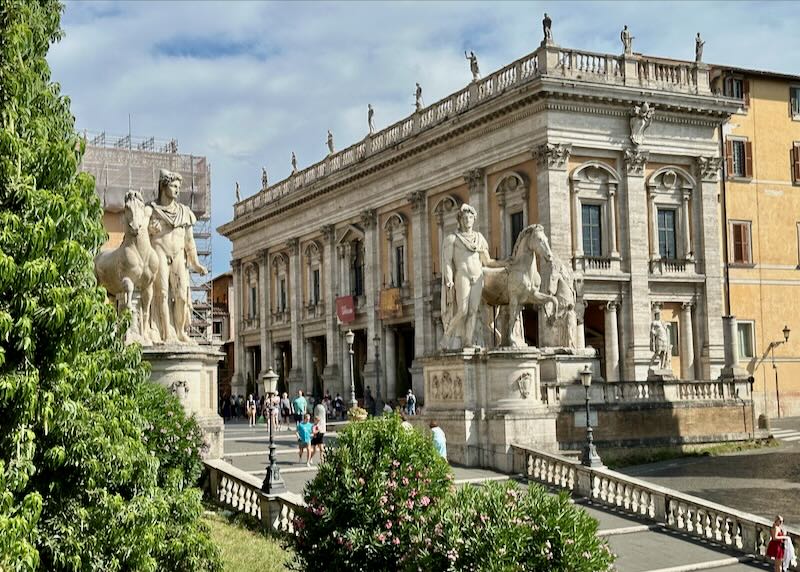
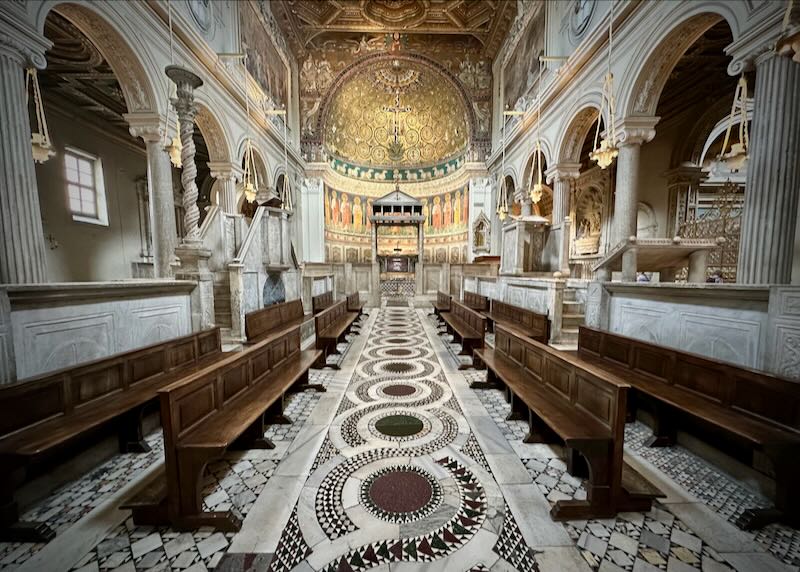
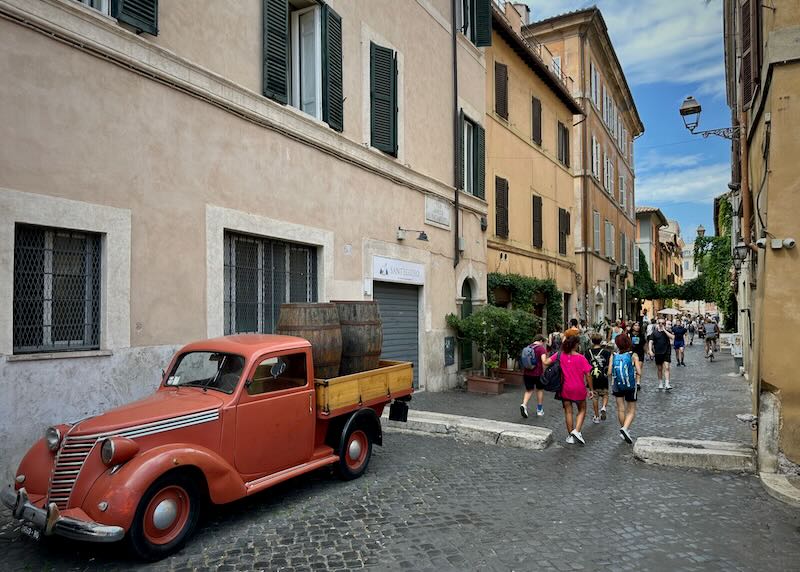

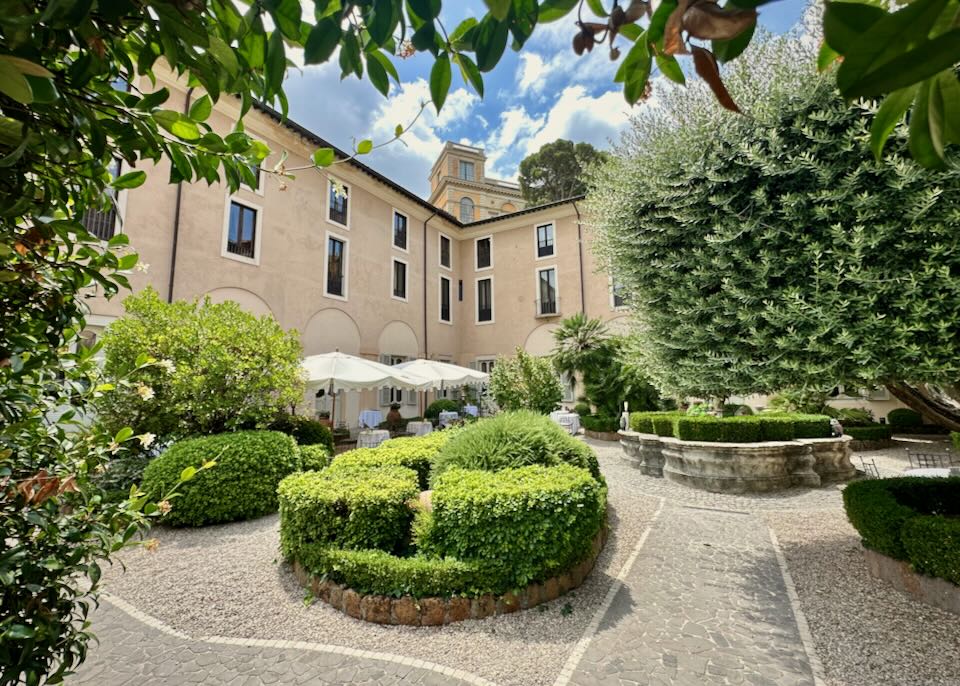
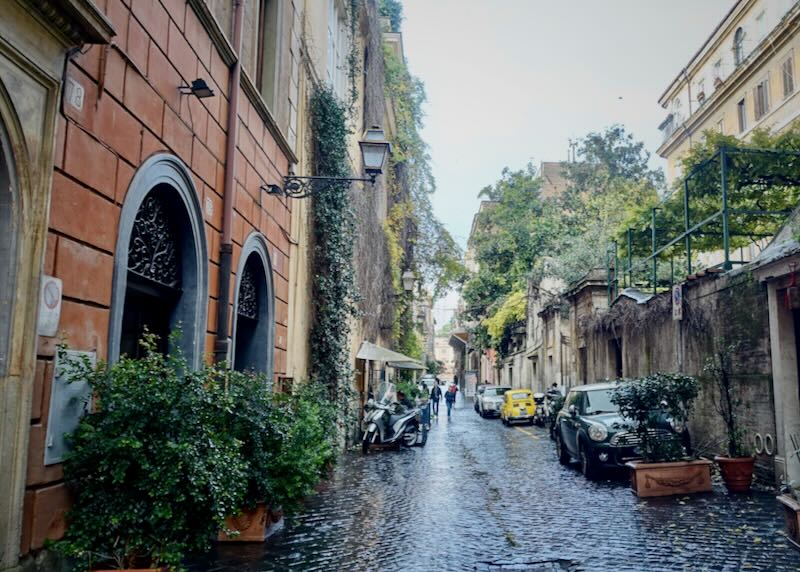

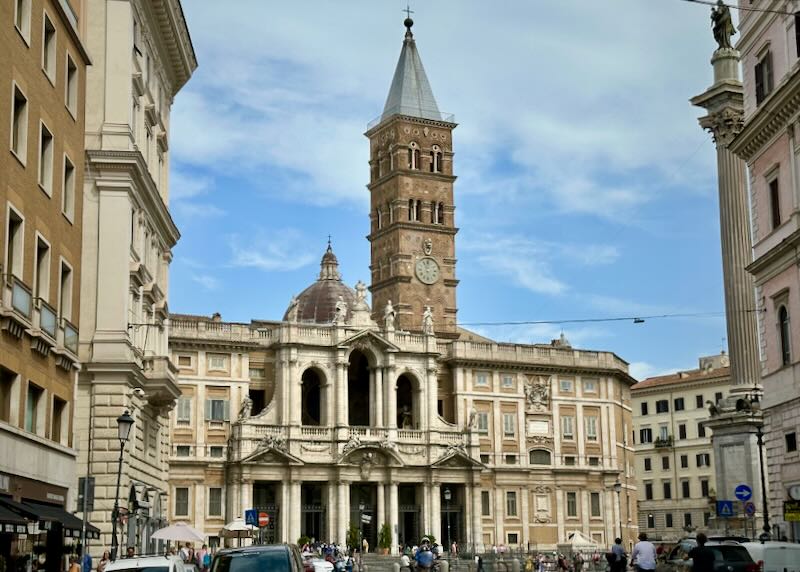

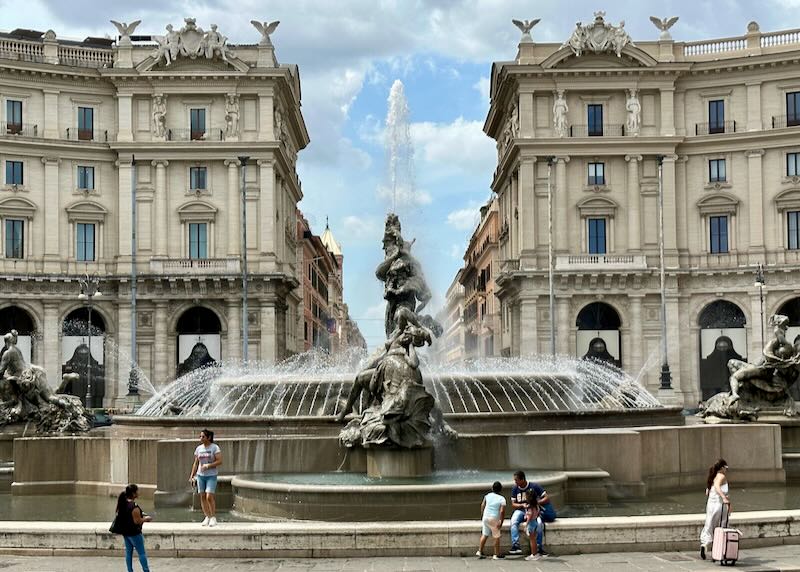
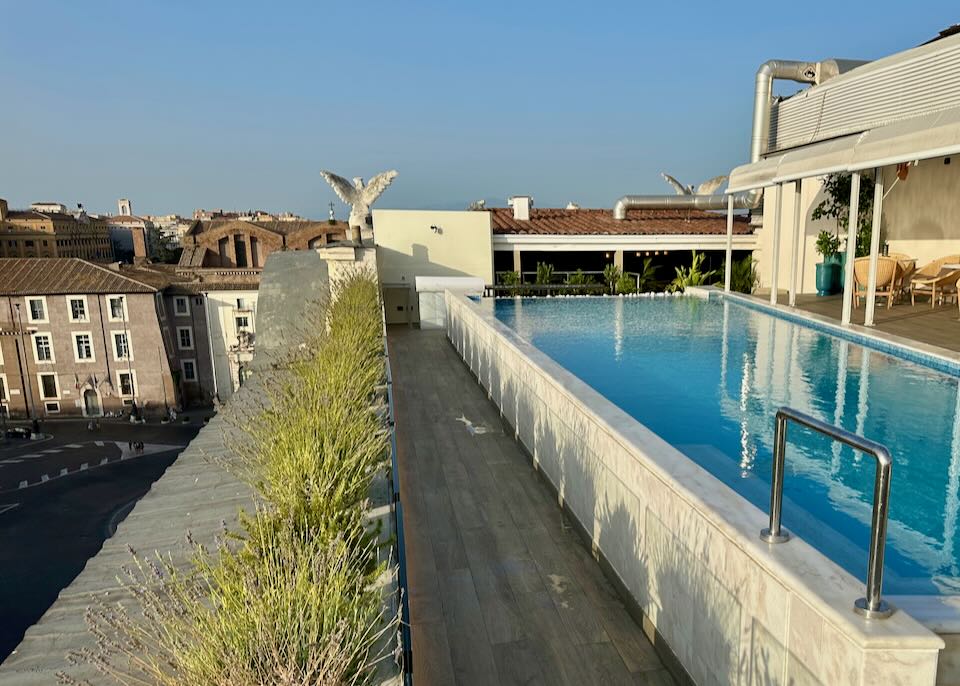
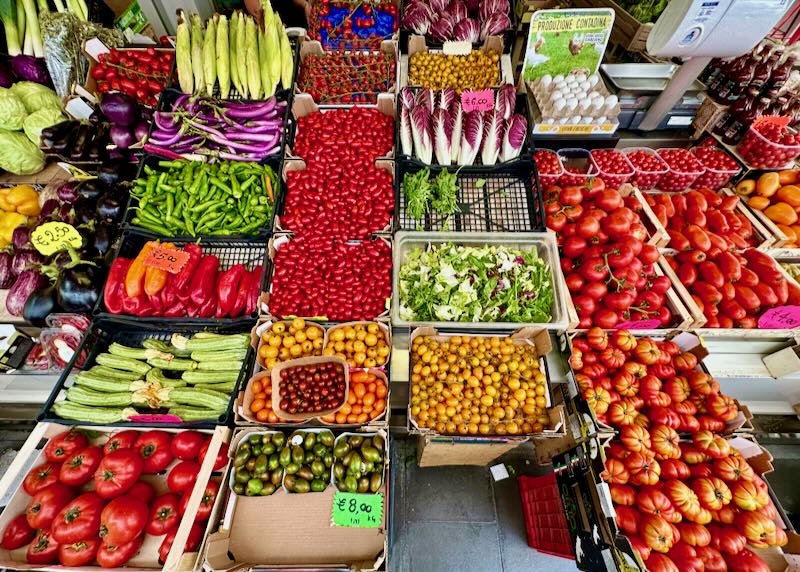

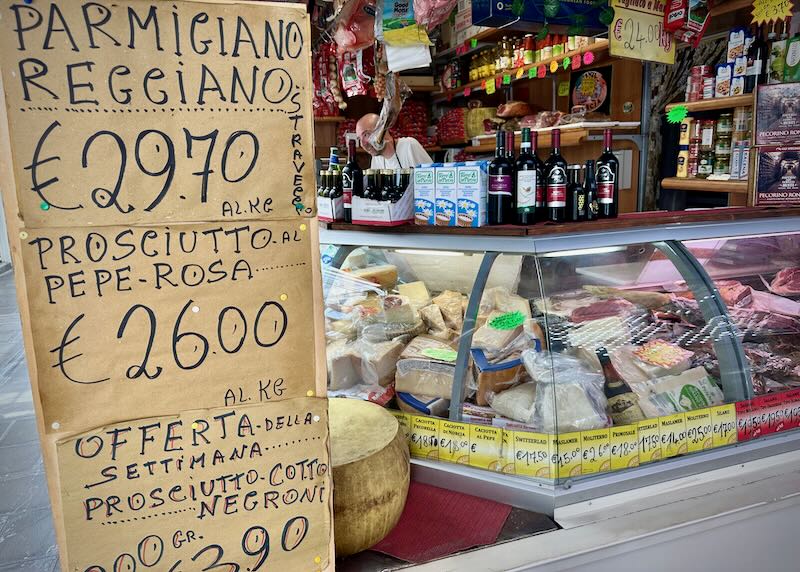
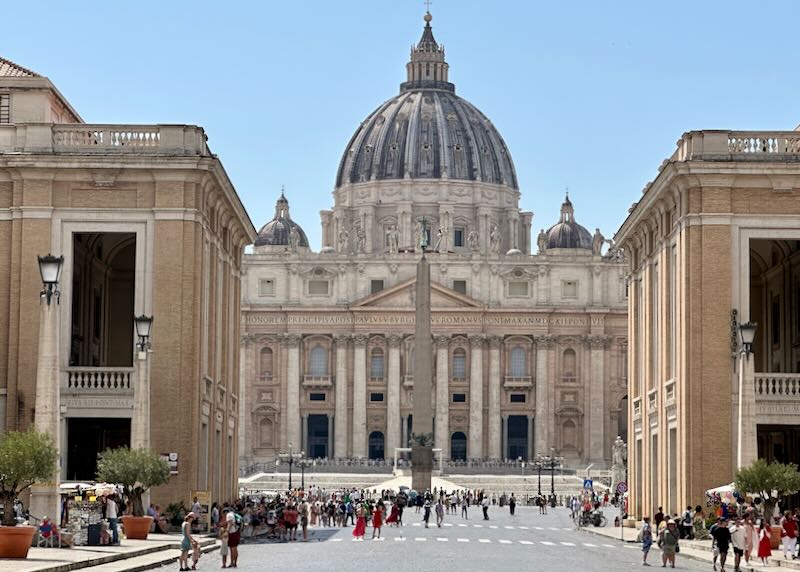

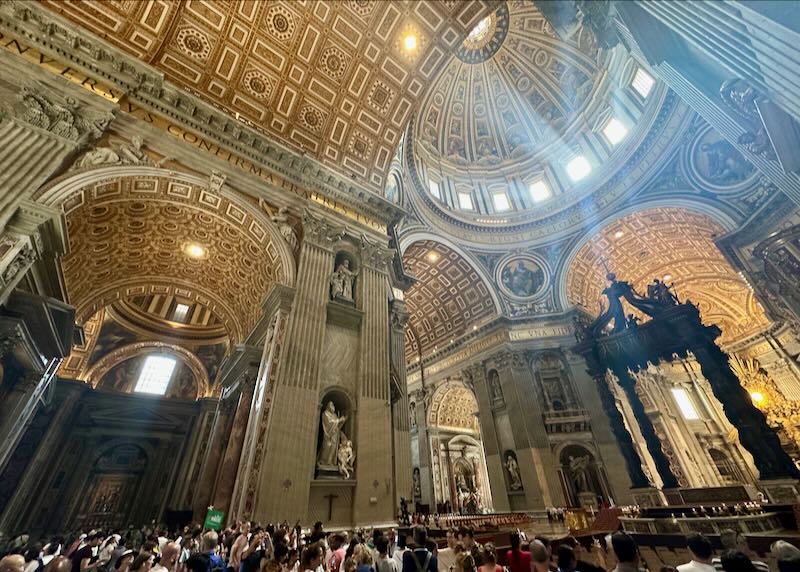
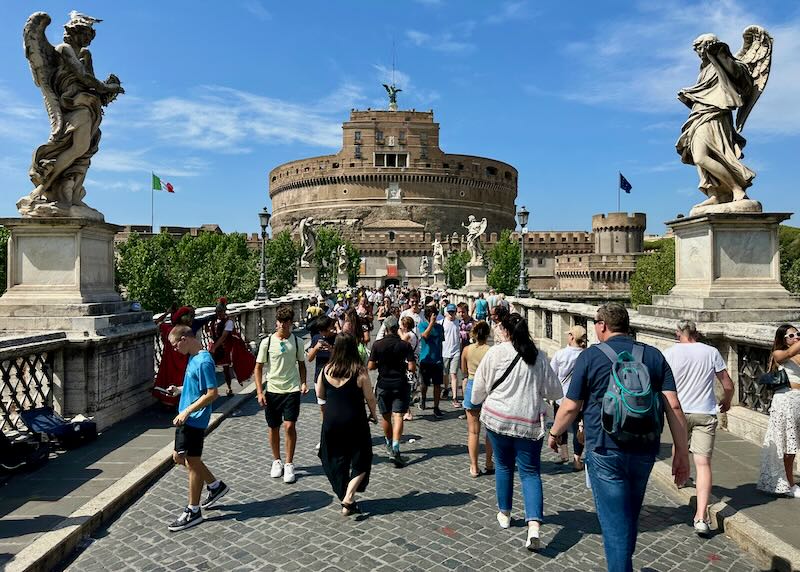
 Santorini Dave was started in 2011 when I posted a short guide to visiting Santorini with kids. Now, my site publishes regularly updated guides to
Santorini Dave was started in 2011 when I posted a short guide to visiting Santorini with kids. Now, my site publishes regularly updated guides to
I’m trying to find a hotel that is within walking distance of the main sights. But the Colosseum and the Vatican seem really far apart on the map. Is there a central location that makes it easy to walk to most places?
The main sights are in two distinct clusters that are far apart.
• Cluster 1 (Ancient Rome): The Colosseum, Roman Forum, Palatine Hill.
• Cluster 2 (Vatican City): St. Peter’s Basilica, Vatican Museums, Sistine Chapel.
The walk between the Colosseum and St. Peter’s Square is about 45 minutes to an hour. That said, Rome is an incredibly walkable city. The key is to stay in a central “sweet spot.” By staying in the Centro Storico (look for hotels near the Pantheon or Piazza Navona), you position yourself directly between these two major poles. From there, you can easily walk to each cluster in about 20-25 minutes, and most other key sights like the Trevi Fountain and Spanish Steps will be less than a 15-minute walk away.
We are planning a trip for late June and I know it will be hot. I also have a bad knee, so climbing a lot of stairs is difficult. Are air conditioning and elevators common in hotels in the historic center, or are these things I need to specifically look for?
No. In the ancient buildings of Rome, air conditioning (aria condizionata) and elevators (ascensore) are luxury amenities, not standard features. You must specifically verify that your hotel has both.
• Air Conditioning: For a trip from late May through September, A/C is absolutely mandatory. Rome can be oppressively hot and humid in the summer. A hotel without A/C will a tough slog. Make this your top priority filter when searching.
• Elevators: Many historic buildings do not have elevators. If they do, they are often tiny, old, and require you to close multiple doors manually. If you have mobility issues or especially heavy luggage, email the hotel directly to confirm the presence and functionality of an elevator. I wouldn’t book a room on an upper floor without this confirmation.
Is there one Rome neighborhood or street that is best for foodies? Looking for the highest density for local wonderful restaurants. Thank you, B.B.
South of the city center, Testaccio is a foodie hotspot. The neighborhood, which once housed the city abattoir, is considered the home of traditional Roman cuisine and there are several restaurants and trattorias specialising in old-school city cooking. It also boasts a hugely popular no-frills pizzeria (Da Remo) and a fabulous deli (Volpetti), reckoned by many one of the best in town. For street food, there’s Trapizzino, a cult takeaway selling chunky wraps made with pizza bases and a choice of fillings, and a number of food stalls at the neighborhood market. A few years back, one of Rome’s top chefs, Cristina Bowerman, opened a hip multi-functional food space in the district. Called Romeo e Giulietta (Romeo and Juliet), it features a pizzeria, restaurant, cocktail bar and deli.
We have 10 days in Rome and looking for a non-touristy area with good local restaurants, markets, etc. Would still like to be close to central sites and attractions (say, within 20 minutes by public transportation). What areas of Rome should we consider? Thanks!
Don
The obvious place that springs to mind is Testaccio. This is a former working class neighbourhood that’s now one of Rome’s top foodie hotspots. Its weekday market has some great food stalls and there are a number of trattorias and restaurants specialising in traditional Roman cuisine. It’s also famous for its nightlife with several popular clubs on Via di Monte Testaccio. Accommodation wise, there are a few top hotels nearby on the Aventine hill. As far as position goes, it’s two metro stops from the Colosseum and within walking distance of Trastevere, another lively and good-looking area. Alternatively, consider Prati near the Vatican. This is a smarter, more upmarket area with lots of good accommodation. It’s well positioned for St Peter’s Basilica and is an easy metro ride from Piazza del Popolo and the Spanish Steps. It’s also good for shopping and has some excellent eateries, ranging from trendy bars to neighbourhood pizzerias and fine dining restaurants.